A Bestiary of Loss
The stories collected are informed by Wikipedia’s list of recently extinct animals, Julian P. Hume’s profoundly detailed Extinct Birds, and many other linked resources. We have also benefited from the Guardian’s Age of Extinction series, Scientific American’s Extinction Countdown, and the Remembrance Day for Lost Species project.
According to many ecologists, we are in the midst of a new mass extinction event. And unlike any other in the Earth's 4.54 billion year history, this one is caused by a single species of primate: humans. Of course, the death of species is a natural part of evolution, but fuzzy estimates put the current rate of loss at somewhere between 100 and 10,000 times higher than background rates. Our current extinction event is closer to the mass die offs caused by volcanic activity and asteroid impacts than any governing force of evolution. This is both old news and recent history. As early humans ventured from Africa to prosper across the globe, they seem to have left ecological devastation in their wake. Paleoindians, for example, are controversially hypothesized to have hunted various species of North American megafauna into extinction: saber tooth cats, giant beavers, and two tonne armadillos longer than a king-size bed.
Images and stories cannot bring back the dead. But we hope this post might help provide a resource for collective mourning, a means to visualize the scale of loss, and perhaps a spur to action. There are 3797 animals currently on IUCN's critically endangered list. We recommend this earth.org introduction on mitigating biodiversity loss; the ranging overview of threats and solutions to animal extinction published by The Solutions Journal, and The Royal Society's biodiversity hub.
Aurochs
Bos primigenius
1627
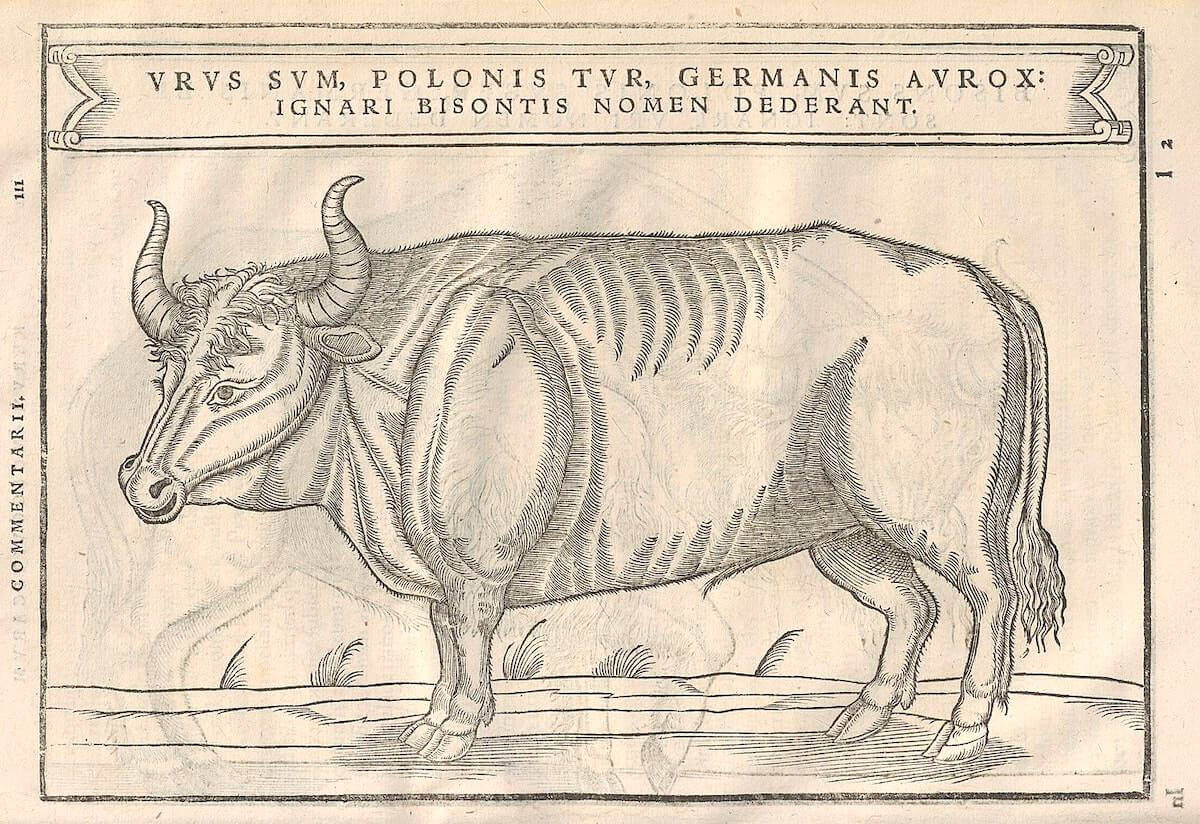
Once widespread in Asia, Europe, and North Africa, the aurochs is believed to be a wild ancestor of domestic cattle. One of the largest herbivores in the Holocene, their grazing of nuts, twigs, and grass shaped historical ecosystems, and their manure supported vast kingdoms of insects and fungi. A prominent participant in human history --- and one of the richest food sources before the advent of agriculture --- aurochs were among the earliest figures to appear in Paleo- and Neolithic cave paintings and petroglyphs, and feature across Egyptian reliefs, Bronze Age figurines, and classical literature. (The Latin "A" descends from a Phoenician character that some believe was originally meant to represent the creature's horns, still visible when inverted: ∀). As forests were increasingly clearcut and pastures enclosed, their populations dwindled. The last surviving herd of aurochs lived in the marshy woodlands of Poland's Jaktorów Forest. The final cow passed away in 1627.
Dodo
Raphus cucullatus
1662
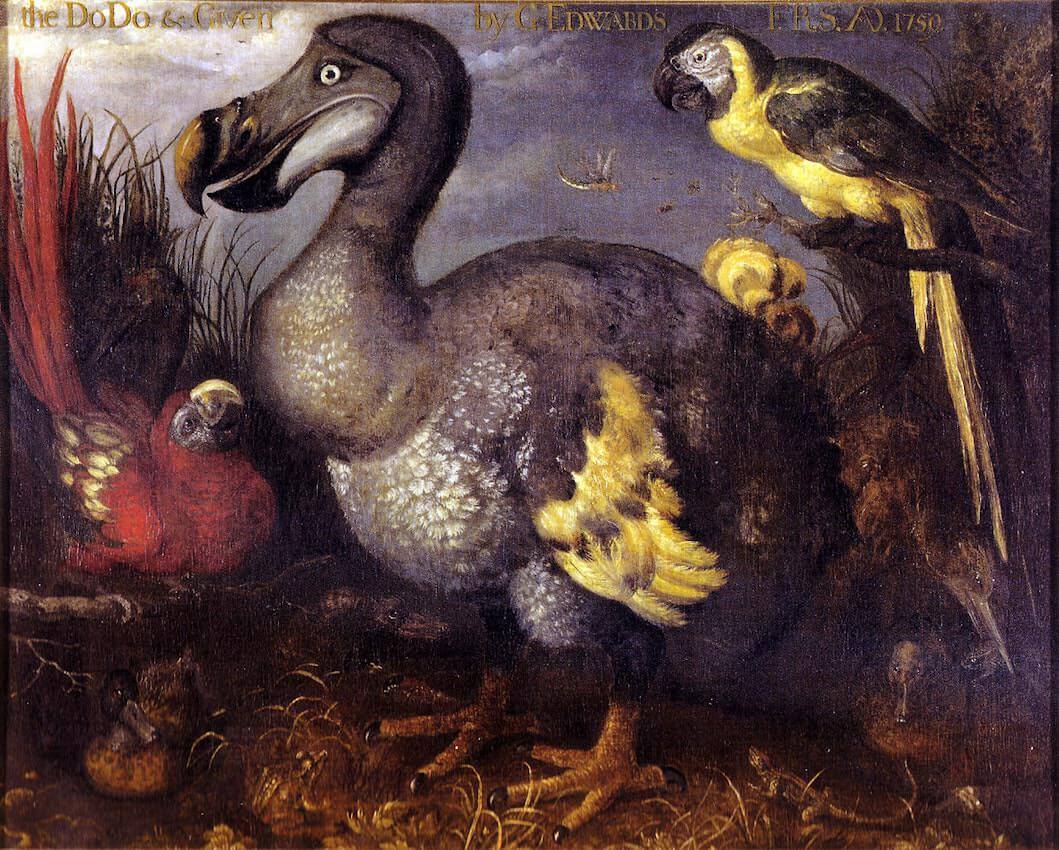
Famously flightless and fearless of humans, the dodo was endemic to Mauritius, evolutionarily forgoing flight due to the richness of abundant food sources and lack of immediate predators. Little remains known about their behavior or appearance (accounting for the varied depiction in naturalist illustrations) due to the narrow research window between their first recorded description, by Dutch sailors in 1598, and last accepted sighting in 1662. Mistaken for an ostrich, albatross, and vulture by colonial explorers, one of the most detailed descriptions of the bird comes from Sir Thomas Herbert's 1634 travelogue, where he characterizes the creature as having eyes like diamonds and being of a "shape and rareness [that] may antagonize the Phoenix of Arabia". Despite being sent to Europe and Asia, the last recorded captive dodo died not long after arriving in Nagasaki. Scientists state with confidence that the animal was probably extinct in the wild by 1700 from habitat loss, the introduction of predators to Mauritius, and overharvesting by humans. First used as an example of human-induced extinction in an 1883 magazine, the bird's memory lives on in Alice's Adventures in Wonderland, where, with perhaps tragic irony, the dodo declares that the best thing to help the animals would be "a Caucus-race".
Steller's sea cow
Hydrodamalis gigas
1768

Once ranging across the North Pacific during the Pleistocene epoch, by the eighteenth century, this sirenian mammal was found only around the Commander Islands in the Bering Sea. Its first recorded encounter with humans occurred in 1741, when the German botanist and explorer George Wilhelm Steller shipwrecked on Bering Island and spent a year researching wildlife while awaiting rescue, which explains how he came to describe the animal's taste as reminiscent of corned beef. An obligate herbivore, we know little about the sea cow's behavior beyond what was observed by Steller, though --- unique for its biological order --- the animal's buoyancy was so great that it was unable to submerge in water, instead harvesting kelp with its toothless, bristled mouth from across the ocean surface. Our knowledge is also limited regarding the cause of the sirenian's extinction, but it is conjectured that populations may have initially dwindled due to hunting by the Siberian Yupik people, and then were further depleted by fur traders traveling the route to Alaska pioneered by Vitus Bering. Literature readers may know the animal as the rare white seal from Rudyard Kipling's The Jungle Book and the poetry of W. G. Sebald. While later sightings were reported in the 1800s and as late as 1962, the official extinction date remains 1768, twenty-seven years after Steller discovered the sea cow.
Bluebuck
Hippotragus leucophaeus
1799
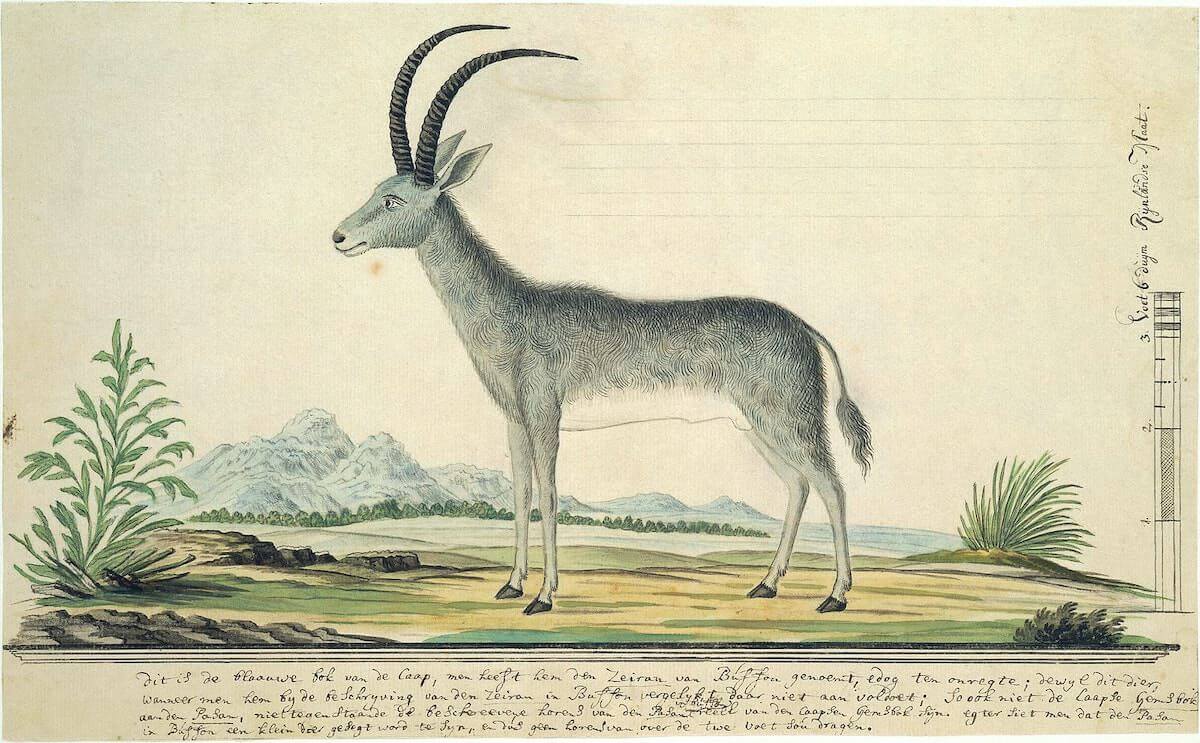
The bluebuck was a species of antelope found in South Africa until the early 1800s. With a lesser mane than roan and sable antelopes, its name derives from a distinct gray-blue coat. When European colonists encountered the animal during the seventeenth century, it was already in decline, due perhaps to a changing grassland habitat around the Cape Peninsula. Hunted to extinction by settlers within a century, biologists did not have long to observe the creature's behavior before it vanished --- many of the extant illustrations of bluebucks seem to have been based on taxidermized specimens. Originally thought to be a blue goat by Welsh naturalist Thomas Pennant, scientists now know that the animal once occupied a larger territory. It appears in shamanic paintings attributed to the San peoples and in Jules Verne's Five Weeks in a Balloon (1863), where the antelope's belly is said to be "as white as the driven snow".
Réunion giant tortoise
Cylindraspis indica
1840
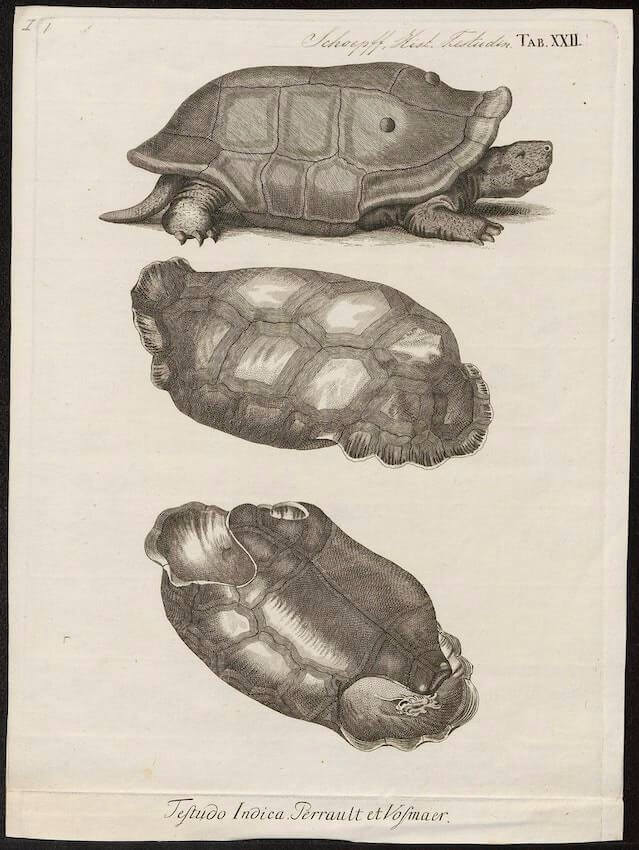
Comparable in size to modern Galapagos giant tortoises, this animal was endemic to Réunion, where its vast creeps were important for maintaining the biodiversity of forests. Noted to be friendly, curious, and without fear, its populations were exploited by passing sailors in need of oil and food, further shrinking when settlers from France and Madagascar began to occupy the island in the seventeenth century. Like its fellow Mascarene giant tortoise species, the animal's slow metabolism allowed it to survive without food or water for extended periods, making it perversely suited for being packed into ship holds. While attempts at preservation were legislated for tortoises on Mauritius in the seventeenth century, meaningful protection was not offered for more than a century. The introduction of invasive species further decimated hatchling numbers, with the final observed tortoises dying off in the 1840s. One of the only taxidermized Mascarene tortoise specimens is kept in the haunting Grande Galerie de l'Évolution's Salle des Espèces Menacées et des Espèces Disparues (The Room of Endangered and Extinct Species) in Paris. As Matt Stanfield writes at the Remembrance Day for Lost Species project, "Disappearing when they did, at a time when modern science was still emerging, the Mascarene giant tortoises occupy a strange halfway house between poorly-understood human-induced casualties of the early modern era and better-known lost species of more recent times."
Southern black rhinoceros
Diceros bicornis bicornis
1850

Historically plentiful in South Africa, southern Namibia, and possibly also Lesotho and Botswana, this species of black rhinoceros went extinct around 1850 due to hunting and habitat destruction. Very little is known about the animal. Carl Linnaeus, who taxonomized the species in 1758, used a holotype of unknown provenance, with some suggesting for a time that the specimen's skull was actually an Indian rhino with a fake horn attached.
Black-fronted parakeet
Cyanoramphus zealandicus
1850
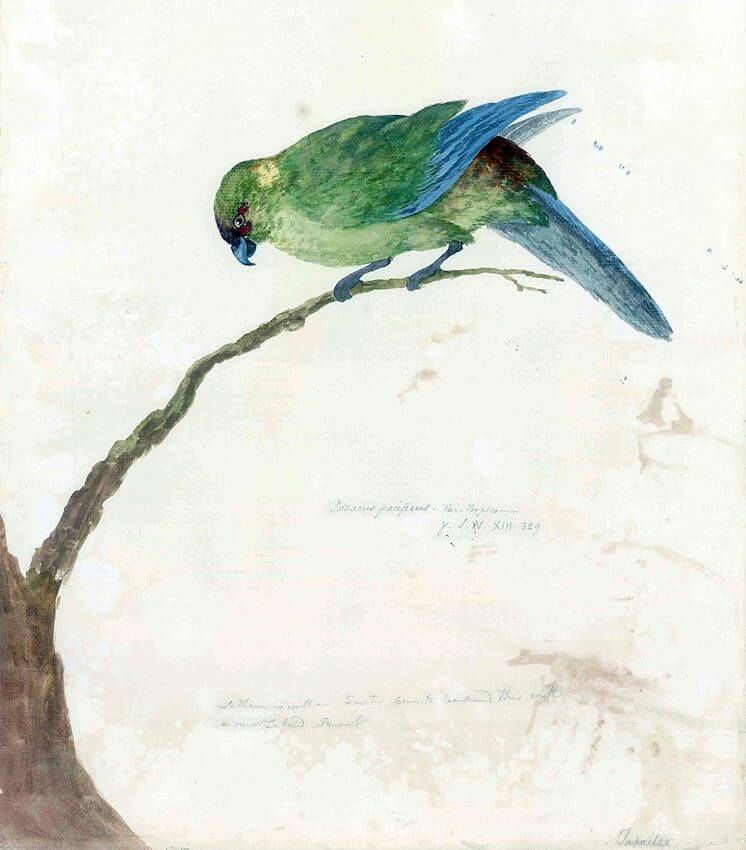
Endemic to Tahiti, the black-fronted parakeet was discovered by Europeans during James Cook's first voyage in 1769 --- when the specimens held in Liverpool and at the Walter Rothschild Zoological Museum in Tring may have been collected. A woodland species with striking violet-blue flight feathers and vibrant red lores, the parakeet survived deforestation, harvesting by Tahitians for handicrafts, and predation by pigs and kiore (Rattus exulans). With the introduction of cats and European rats to Tahiti, the black-fronted parakeet quickly became extinct as these creatures preyed on the birds and their nests, with the last reported sighting in 1850.
Hoopoe starling
Fregilupus varius
1850
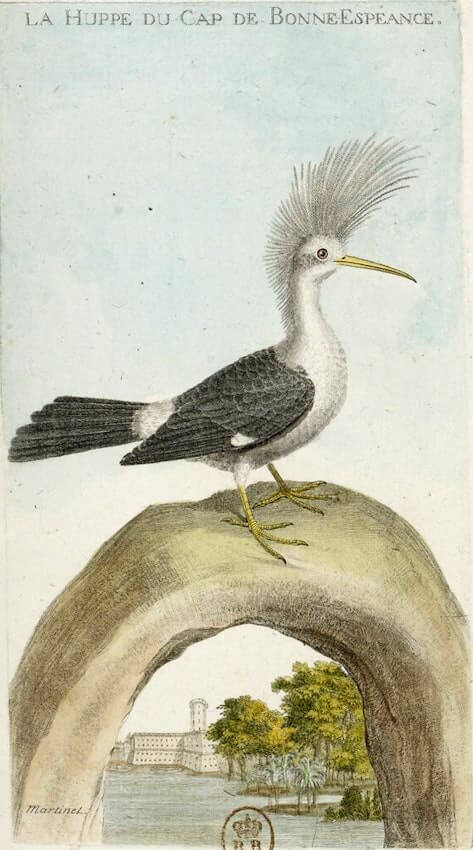
Once populating Réunion, this species of starling is thought to have been first recorded by Étienne de Flacourt of the French East India Company in 1658. It was noted to be delicious by Sieur Dubois in 1674, especially "when it is fat" --- a reference to the bird's summer feeding cycles. As a twentieth-century natural historian elaborated somewhat caustically: "It became very fat in June and July, and may have itself been used for food, for it had none of the usual starling alertness, being so stupid that it could easily be knocked down with a stick." Despite this same scientist proclaiming the passerine's extinction to be "an ornithological mystery", Julian P. Hume argues that extreme deforestation was the cause, with contemporary observers recording mass culling to increase the productivity of farms. (In 1807, for example, Levaillant charged the starling with causing "big damage to coffee trees".) Eulogizing the bird's extinction in the mid-nineteenth century, Eugène Jacob de Cordemoy wrote: "I have known the bird you ask me about since childhood . . . . After ten years spent in Paris I did not find a single one in the forests where formerly they flew about in flocks. All ruthlessly destroyed. I shall never forgive myself for the part, slight though it was, which I took in the matter."
Great auk
Pinguinus impennis
1852
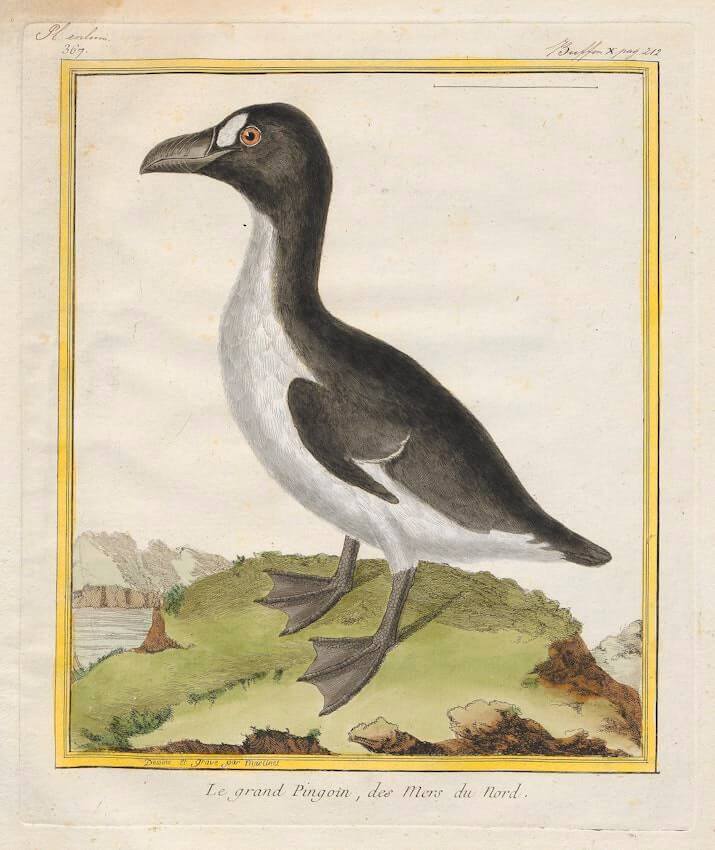
Classed as a flightless alcid, and the only modern species of the genus Pinguinus, this creature gave its name to penguins, as Atlantic sailors believed the latter birds were related to the auk. Historically ranging between eastern North America, Scandinavia, and the Strait of Gibraltar, the great auk mated for life, weighed about five kilograms (eleven pounds), and gurgled when anxious. Human history is tightly entwined with the bird. Its bones have been found around Neanderthal campfires, Native American burial grounds, and it helped European sailors navigate toward the Grand Banks of Newfoundland when adrift at sea. Last officially sighted in 1852, after its swift decline in the hands of harvesters selling its soft down to European clothiers, the bird's conspicuous absence resulted in novel --- though ineffective --- protective legislation to be passed in 1753. The long-running ornithology journal The Auk was named in its honor.
Falkland Islands wolf
Dusicyon australis
1876
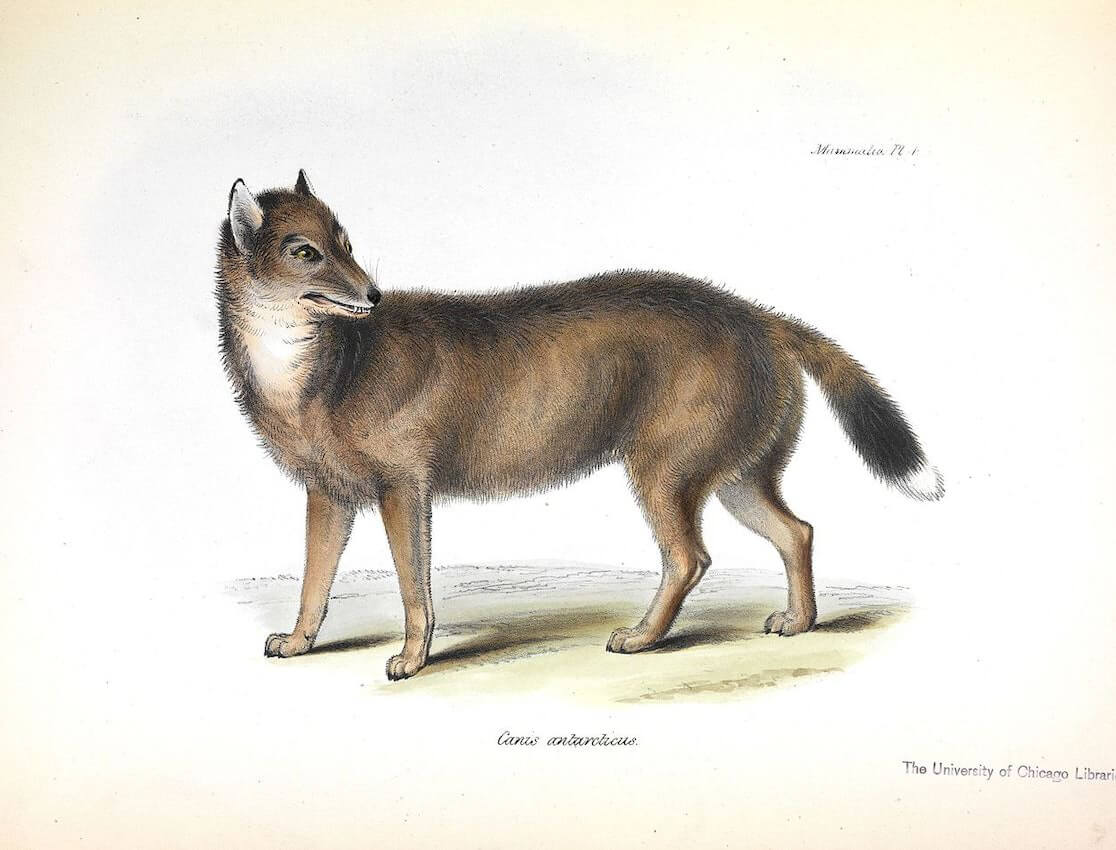
"We barely knew the warrah", begins a recent National Geographic feature on the Falklands Islands wolf. It was first sighted by Captain John Strong in 1690, studied by Charles Darwin in 1833, and then, forty years later, was nevermore. The animal had a reputation for foxlike slyness, hence its original French name, loup-renard (wolf-fox). Darwin remembered how one stole "some meat from beneath the head of a sleeping seaman". While Thomas Huxley classed the Falklands wolf as a coyote, it is closer to the South American fox (itself not a true fox). The only endemic mammal to the Falkland Islands, the wolf was assumed to have crossed on an Ice Age land bridge to the unpeopled archipelago in some prehistoric time. Yet recent genetic research suggests that the animal left its mainland ancestors in the recent geological past (16,000 years ago), and may have been accompanied by human companions. It was hunted to extinction.
Quagga
Equus quagga quagga
1883

Named for an onomatopoeic Khoikhoi word for zebra --- thought to mimic the creature's equine call --- the quagga was endemic to South Africa until it was hunted to extinction by European settlers in the late nineteenth century. Brown and white striped, it was known to roam in herds of fifty. William Cornwallis Harris, an English military engineer and big game hunter, described the collective movement during its summer migration, unwittingly capturing the quagga's place in a landscape rich with biodiversity: "Bands of many hundreds are thus frequently seen doing their migration from the dreary and desolate plains of some portion of the interior, which has formed their secluded abode, seeking for those more luxuriant pastures where, during the summer months, various herbs thrust forth their leaves and flowers to form a green carpet, spangled with hues the most brilliant and diversified." For centuries before extinction, the quagga played an important part in human culture and agriculture, appearing in cave paintings attributed to the San peoples and used to safeguard livestock by Afrikaner farmers. When a hybrid --- the offspring of a quagga that was crossbred with a horse --- gave birth to striped children, it led to breakthroughs in theories of telegony. Writing in 1889, naturalist Henry Bryden eulogized the loss of the quagga: "That an animal so beautiful, so capable of domestication and use, and to be found not long since in so great abundance, should have been allowed to be swept from the face of the earth, is surely a disgrace to our latter-day civilization." Extinct by 1900, a stuffed quagga is held by Leiden's Naturalis Biodiversity Center, where it is trotted out for special occasions.
Portugese ibex
Capra pyrenaica lusitanica
1892
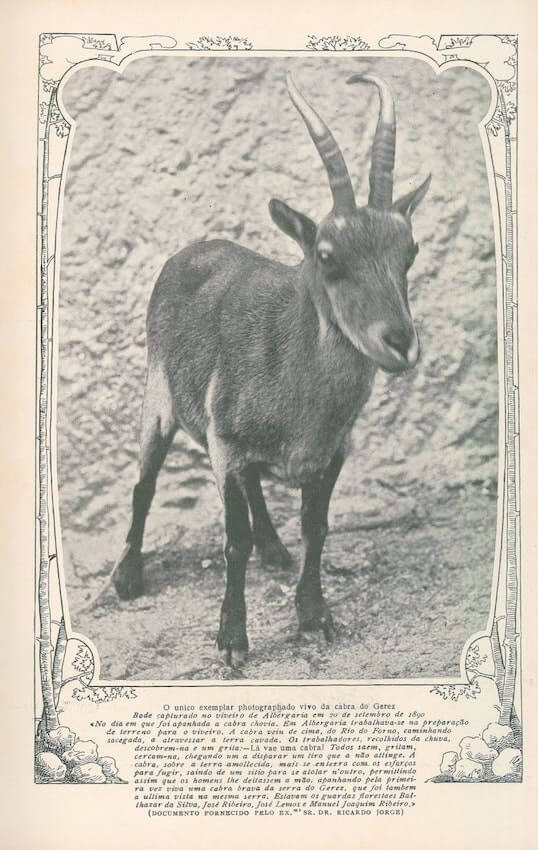
Half the length of its Pyrenean relative, there remains some debate whether or not the Portuguese ibex was a subspecies or a species of its own. Hunted by mountain-dwelling locals for meat, its ornamental horns, and the seemingly magical stone-like bezoars found in the animal's gastrointestinal tract, its decline tracks the spread and advancement of firearms. "There is little doubt that the Cabro's only significant enemy was Man", writes David Day in The Doomsday Book of Animals: A Natural History of Vanished Species (1981). The last known Portuguese ibex died in 1890, although a lone female was spotted near the Serra do Gerês in 1892.
Harelip sucker
Moxostoma lacerum
1893
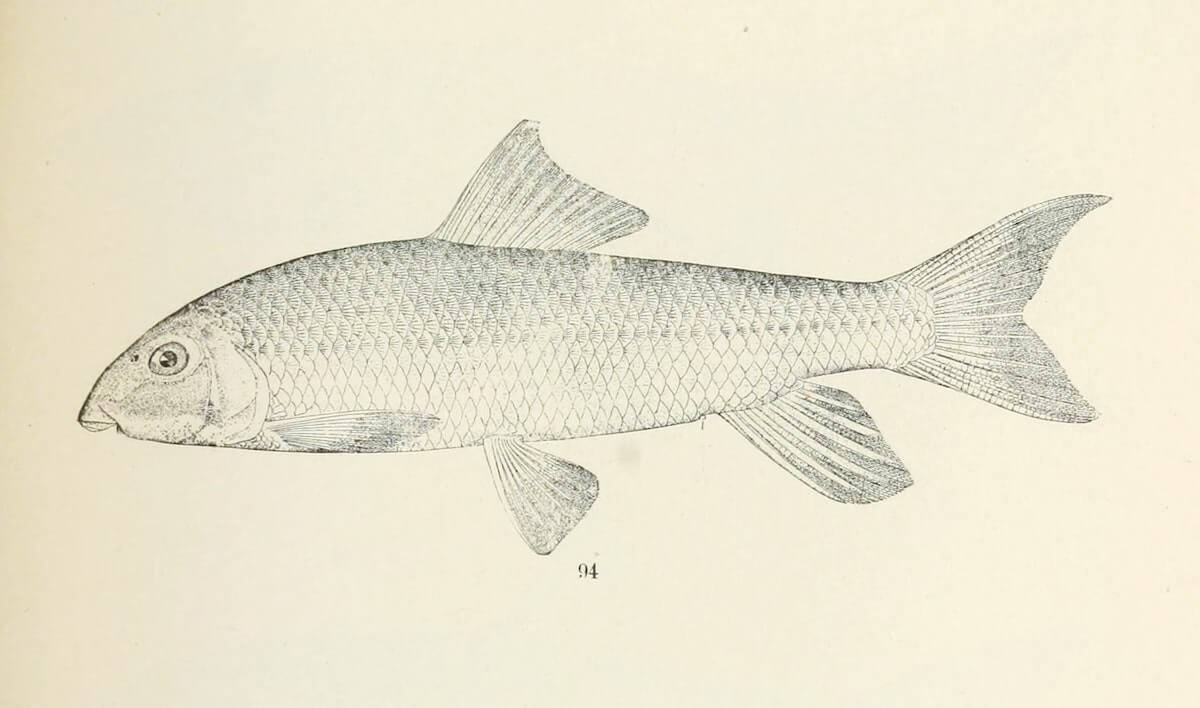
A species of ray-finned fish found only in the United States, the harelip sucker has not been seen since 1893. Once considered by fishermen in Georgia, Alabama, and Tennessee as "the commonest and most valued species of sucker", it had an olive-colored back, a nonprotractile upper lip, and a notably short head. The reasons for its extinction are uncertain, but scientists suggest that the sucker died off by the siltation of its freshwater habitat through deforestation, which impacted the fish's ability to see the snails, limpets, and crustaceans on which it fed.
Sooty crayfish
Pacifastacus nigrescens
1900
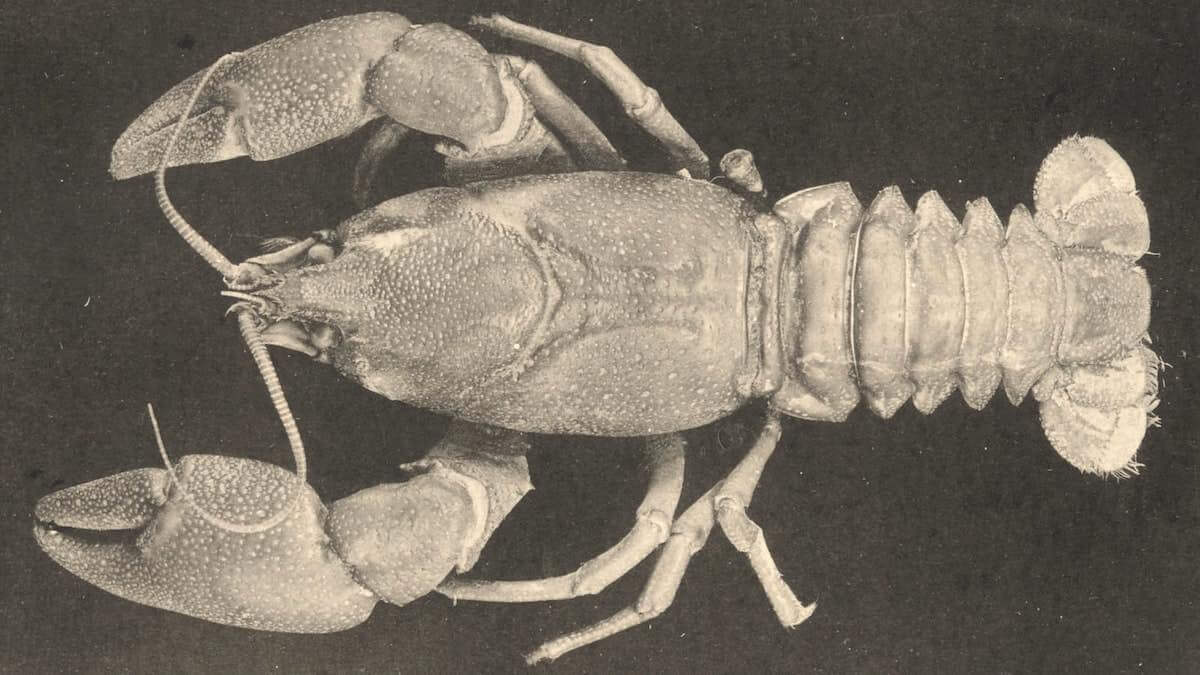
Once endemic to the San Francisco Bay Area --- specifically Alameda Creek, Coyote Creek, and Steamboat Slough --- the sooty crayfish was declared extinct in 2010. It probably disappeared earlier, as it was not sighted for the entirety of the twentieth century, vanishing from its native waters as the signal crayfish was introduced, a species that carry a water mold known as crayfish plague. Overharvesting and development of the Bay Area may have also contributed to its demise. It resembled the Shasta crayfish, but was smaller and blacker in color, rarely exceeding two inches (fifty-one millimeters) in size.
Rocky Mountain locust
Melanoplus spretus
1902

This species of grasshopper was an infamous decimator of prairie farms in the 1870s. One swarm, recorded in 1875 and named after the observing physician Albert Child, was calculated to number between 3.5 and 12.5 trillion insects, encompassing some 198,000 square miles (510,000 square kilometers) of land. A western Missouri historical record remembers how they gave "an earnest and overwhelming visitation, and demonstrated with an amazing rapidity that their appetite was voracious, and that everything green belong to them for their sustenance." Its taxonomic specific name (spretus) captures the human attitude toward the grasshopper, deriving from the Latin word for "despised". (Entomologist Charles Valentine Riley invented a recipe for butter-fried locusts during blight, but was met with a public who "would just as soon starve as eat those horrible creatures".) The swarms, described by one farmer as "like a great white cloud, like a snowstorm, blocking out the sun like vapor", became a rare site in the twentieth century, due, it is thought, to the expansion and irrigation of farmland and trampling of breeding grounds by livestock. As extinction ripples up and down the animal kingdom, the Eskimo curlew's critical endangerment (or possible extinction) is thought to stem from the loss of this vital food source. The locust was formally declared extinct in 2014. Laura Ingalls Wilder's On the Banks of Plum Creek (1937) captures the awesome force of these lost locust swarms.
Bulldog rat
Rattus nativitatis
1903

Once endemic to Christmas Island in the Indian Ocean, the bulldog rat was russet colored, dwelling on hills and in thick forests. The creatures' demeanor has been described as sluggish --- avoiding daylight, for it dazed them, and never climbing into trees or shrubs. They were last seen in 1903, when sailors observed mass die offs, which were later attributed to diseases carried by black rats that had stowed away on colonial ships. Its murine neighbor on Christmas Island, Maclear's rat (Rattus macleari), followed it into extinction soon after. In March 2022, researchers in Current Biology speculated about a possible pathway toward de-extinction through gene editing, prompting some Jurassic Park style fearmongering in the popular science news.
Black mamo
Drepanis funerea
1907
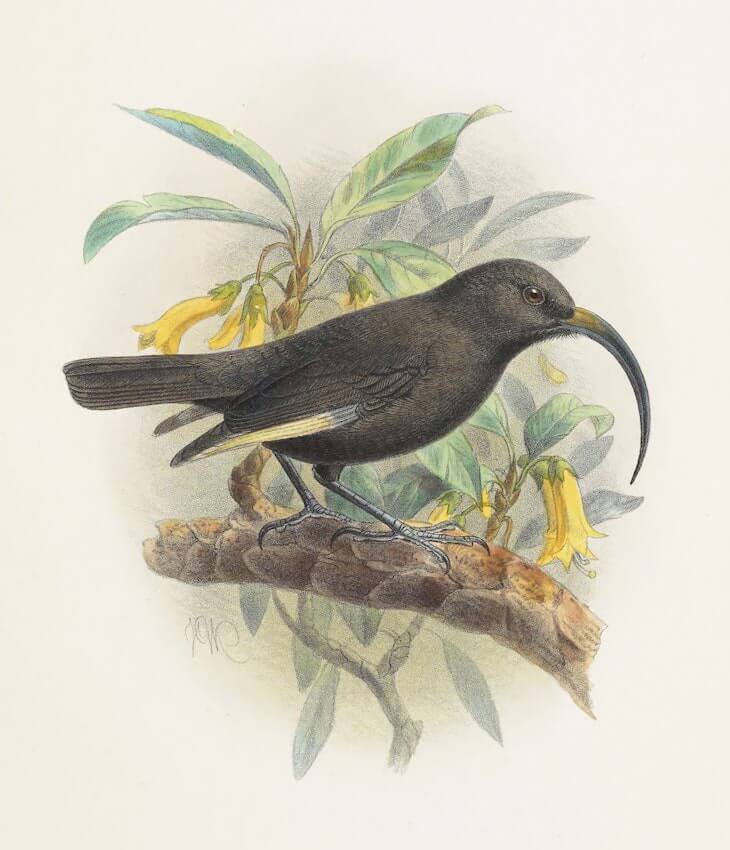
Lithograph by John Gerrard Keulemans of a black mamo from Lionel Walter Rothschild's The Avifauna of Laysan and the Neighbouring Islands (1893) -- Source
Known as the hoa on its Hawaiian island of Molokai --- with a fossil record also found on the neighboring Maui --- the black mamo was known for its highly decurved bill, often dusted with pollen from lobelia flowers. Killed off by habitat destruction and the introduction of rats and mosquito-borne diseases, the last recorded specimens were captured in 1907, only fourteen years after its first recording by European naturalists. Its Latin name funereal, the same root from which we derive the word "funeral", tragically hints toward its doomed future. Alfred Newton, who taxonomized the bird, wrote that "Its sombre plumage and the sad fate that too probably awaits the species induce me to propose for it the name Drepanis funerea". Yet the bird's behavior was anything but funereal, for it was remembered as a markedly curious creature, which would seek out human proximity and respond to manmade imitations of its call. William Alanson Bryan, who published a natural history of Hawaii in 1915, captured the beauty of the bird's feeding, before loading his shotgun and killing the last specimens ever collected: "The tongue was inserted with great precision, up to the nostrils, in the flower, while the bird balanced itself on the branches, assuming almost every imaginable attitude in its operations. In all three of the birds secured, the crown was smeared with the sticky purplish white pollen of this lobelia."
Sloane's urania
Urania sloanus
1908

Named after Sir Hans Sloane, whose private collection helped found the British Museum, this species of moth was endemic in Jamaica until the last reported sighting around 1895. Its neon green, red, and blue coloration was achieved by refracting light off of ribbon-like scales, a warning to predators of its toxicity. The diurnal species lived a migratory existence, known for suddenly vanishing from areas it had previously called home. Scientists speculate that this behavior was a response to plants gradually releasing chemicals to ward off being eaten by caterpillars, accounting for an abnormal death rate observed in wild larvae broods. Sloane's urania may have succumbed to habitat loss after Jamaica's lowland rainforests were cleared and converted to agricultural land, hindering its nomadic movements.
Tarpan
Equus ferus ferus
1909
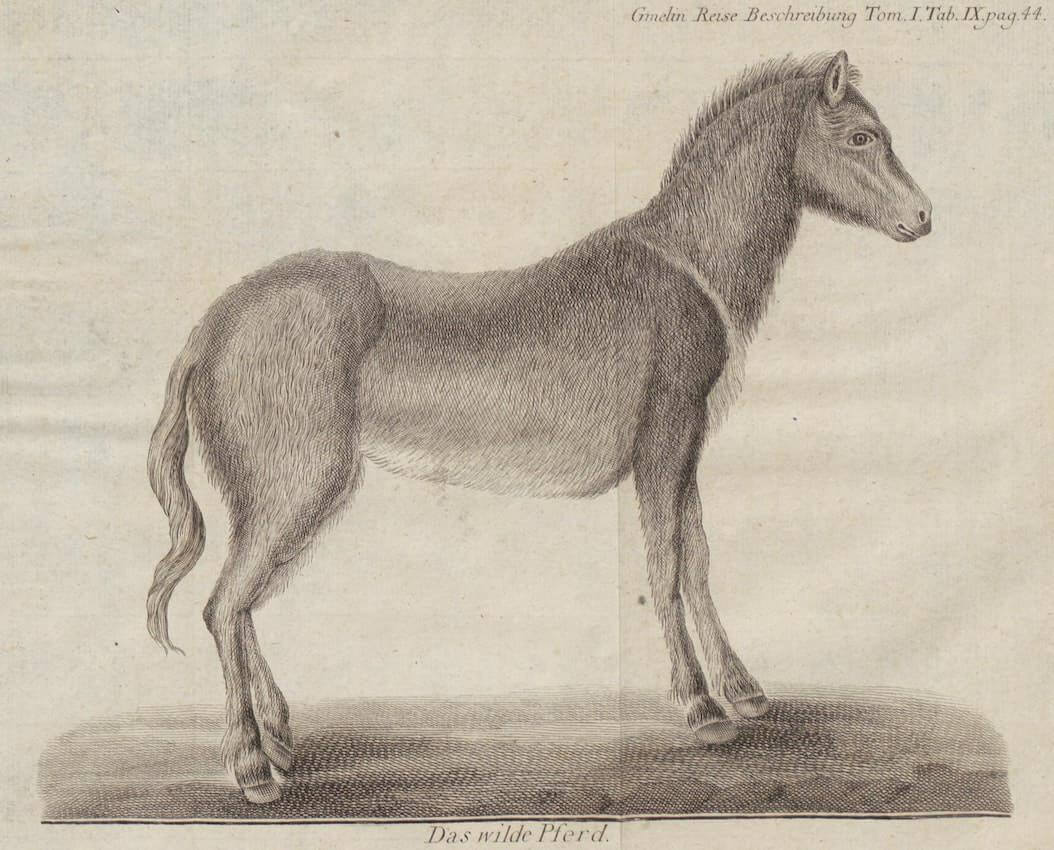
A species of small, free-ranging horse from the Russian steppe, it is uncertain whether tarpans were wild or feral creatures, hence their ferus taxonomy. They were first described by the German botanist Samuel Gottlieb Gmelin in 1771 and the last tarpan is thought to have died in captivity in 1909. They varied in color, resembling ancient depictions found in cave paintings made in Europe during the Pleistocene epoch, and some may have carried the "dun gene", sporting a blue grullo coat. They were hunted to extinction. Many domesticated horses bear phenotypic traits of the tarpan.
Passenger pigeon
Ectopistes migratorius
1914
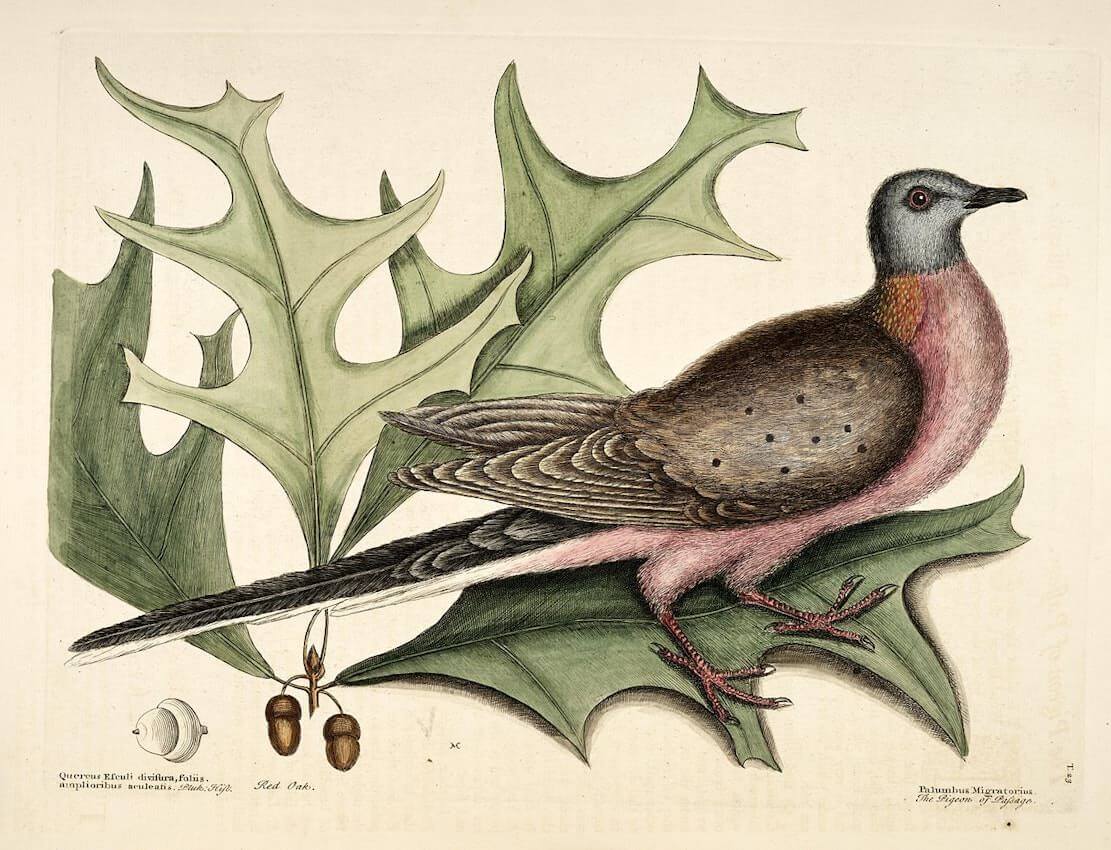
This wild North American pigeon was named not for its ability to transport passengers, but for its wanderlust tendency to pass by (passager, in the French), before gradually passing out of existence for good, due to hunting and widespread deforestation in the nineteenth century. Living in the deciduous groves of eastern North America and breeding around the Great Lakes, the passenger pigeon's population at one point numbered between three and five billion. (A similar number range occurs in the dating of its oldest known fossil: from a specimen found in North Carolina estimated to be between 3.6 to 5.3 million years old.) It could reach airborne speeds of sixty-two miles (one hundred kilometers) per hour and caught light in its iridescent neck feathers. Wallace Craig attempted to record a different kind of tonal richness: the male pigeon's vibrant vocalizations, in musical notation and phonetic imitation, as it moved gently toward its mate: "kee-kee-kee-kee", "tete! tete! tete!" This chattering call sounded from one of the most social land birds, whose scale of loss is almost inconceivable: at their peak, passenger pigeon populations were about equal in number to all the birds that currently overwinter in North America. To give a sense of this figure, Christopher Cokinos believes that if all of the pigeons flew in a single line, they would have ringed Earth twenty-two times. For fifteen thousand years, before the arrival of European colonizers, Native American land-use practices, it is thought, worked in symbiotic relation with the birds --- promoting tree species that produced nuts, acorns, and fruits upon which the pigeons fed.
Carolina parakeet
Conuropsis carolinensis
1918
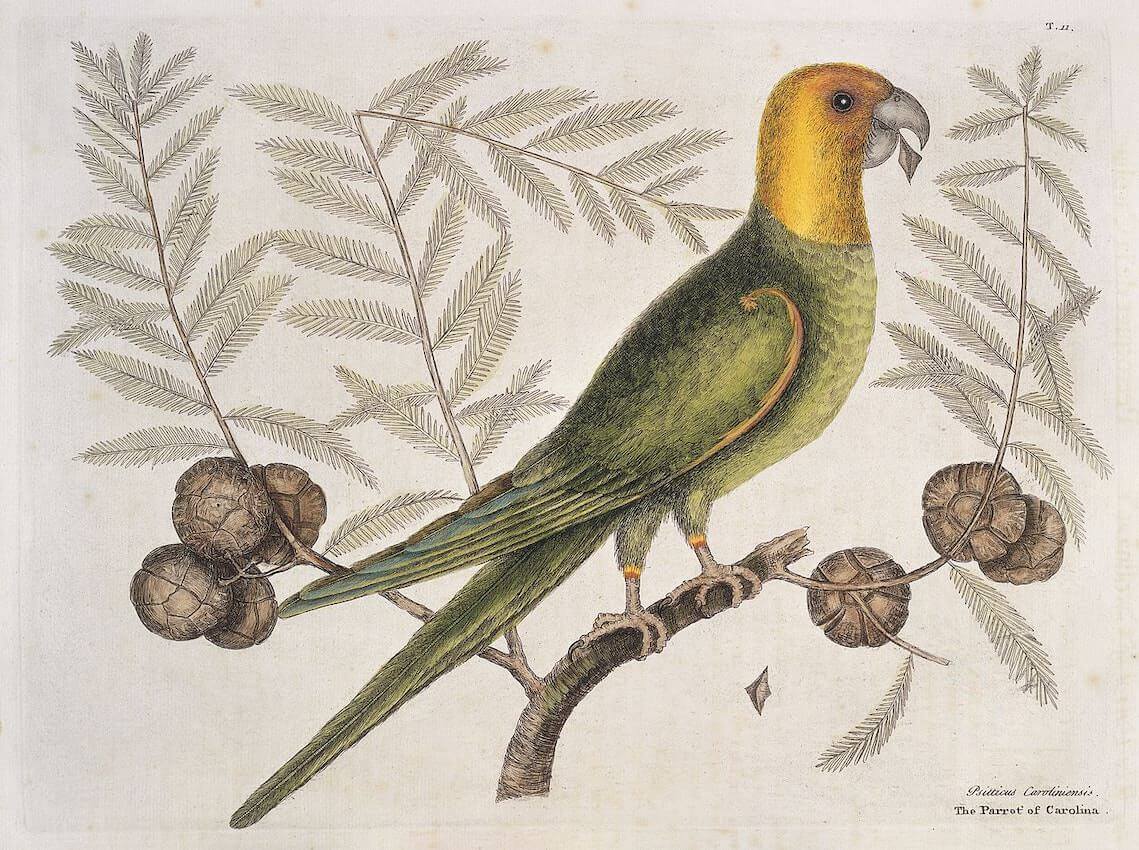
The Carolina parakeet shares a bleak historical affinity with the passenger pigeon: the species were known to flock together, and four years after the death of Martha, the last passenger pigeon, Incas --- the final captive Carolina parakeet --- died in the same cage. This small green bird, with a lemon-yellow head and ruddy face, was the only indigenous parrot to the eastern Midwest and plains states, and one of only three parrots native to the United States. It was first recorded by the English merchant venturer George Peckham in his A True Report of the Late Discoveries of the Newfound Lands (1588). The birds are thought to have been poisonous, due to cats who succumbed shortly after preying upon the parrots. Their voices imbue numerous European colonial travelogues, for the sound of parrots' cries were inseparable from the soundscape of arrival in the New World: the birdcall of a genus that did not live in Europe. Edward McIlhenny, son of the Tabasco pepper sauce tycoon, attempted to imitate their call: "While on the wing they chatter and cry continually; this cry sounds like 'qui' with the rising inflection on the i; this is repeated several times, the last one being drawn out like 'qui-i-i-i'." Yet by the nineteenth century, travelers were already noting the mournful silence that signaled their decline. The cause of their extinction is multifold: deforestation, hunting, capture by the pet trade, and competition for nesting sites by introduced species. Known to flock to the site of dead and dying birds, opportunists would exploit this behavior for wholesale slaughter.
Florida black wolf
Canis rufus floridanus
1934
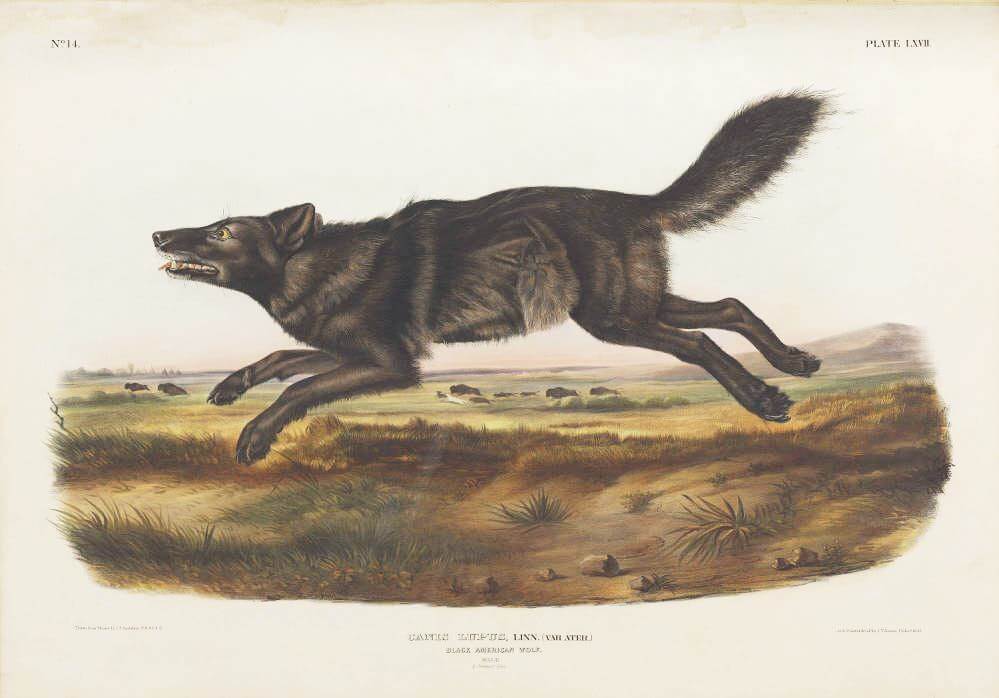
Once roaming throughout the lower southeast of the United States, the Florida black wolf hunted bison in prairies and pine forests. While initially thought to be a type of coyote, scientific consensus now believes that the animal was a subspecies of red wolf. Jet black, with the exception of white highlights on its chest and snout, this predator was declared extinct in 1908, forced out of its natural habitat by homesteaders pushing into the hinterland, who saw the wolf as a threat to livestock.
Hawaiʻi ʻōʻō
Moho nobilis
1934

Reportedly common on the Big Island in 1891 and 1892, this yellow-tufted bee-eater had disappeared two years later, which contemporary observers believed resulted from prize hunting and from forest lands being cleared for coffee plantations and browsing livestock. The last specimen was collected in 1902, although a senior Hawaiian ornithologist swears to have heard one hidden amid the flanks of the active volcano Mauna Loa in 1934. Notably timid, the nectivorous ʻōʻō had an extended tongue for probing lobelias and made a hummingbird-like buzzing while hovering. Robert Perkins, who Julian Pender Hume describes as spending weeks on the mountains of Hawaii bare-foot and on horseback, recorded the bird as displaying an aggressiveness that "appears so wanton and unnecessary, and so frequently interrupts its own feeding, that one suspects it must be an ancient habit, which has survived from a time when either nectar-producing flowers were scarcer, or the birds which feed upon them were more numerous." The islands of Molokai and Maui also were home to species of Moho, which --- like the Hawai'ian ʻōʻō --- are now extinct.
Thylacine (or Tasmanian tiger)
Thylacinus cynocephalus
1936
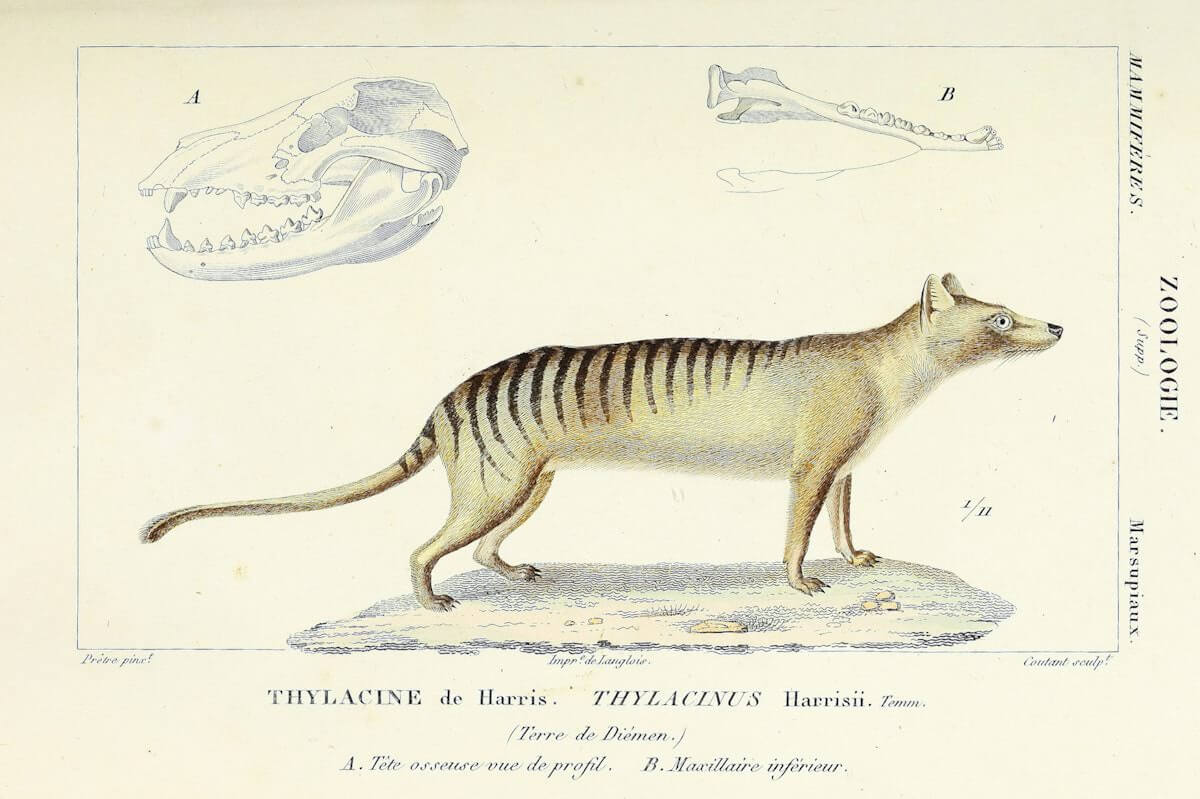
The darkly-striped thylacine was a marsupial, not a tiger, and had many canine characteristics. Formerly it lived on New Guinea and the Australian mainland, but met its end on Tasmania, with the last captive specimen outside of Oceania dying in 1931. Its tigrine features are present in rock art dating back to at least 1000 BCE. Observing the animal's footprints in 1642, Dutch colonist Abel Tasman described them as "wild beasts having claws like a Tyger". Surprising settlers by sporting a kangaroo-like pouch, the thylacine's combination of characteristics led it to be later described as a "dog-headed opossum" by naturalists, and a transformation of the striped archerfish by Kunwinjku Aboriginals. Thought to have been hunted to near extinction by early humans, the last thylacines succumbed to bounty schemes introduced by Van Diemen's Land Company in the nineteenth century, after thylacines were blamed for the death of sheep, with what is thought to be the final thylacine shot by a farmer named Wilf Batty in 1930. Before extinction, its visual hybridity inspired a wealth of engravings, lithographs, and drawings, collected in Carol Freeman's Paper Tiger: A Visual History of the Thylacine.
Toolache wallaby
Macropus greyi
1939
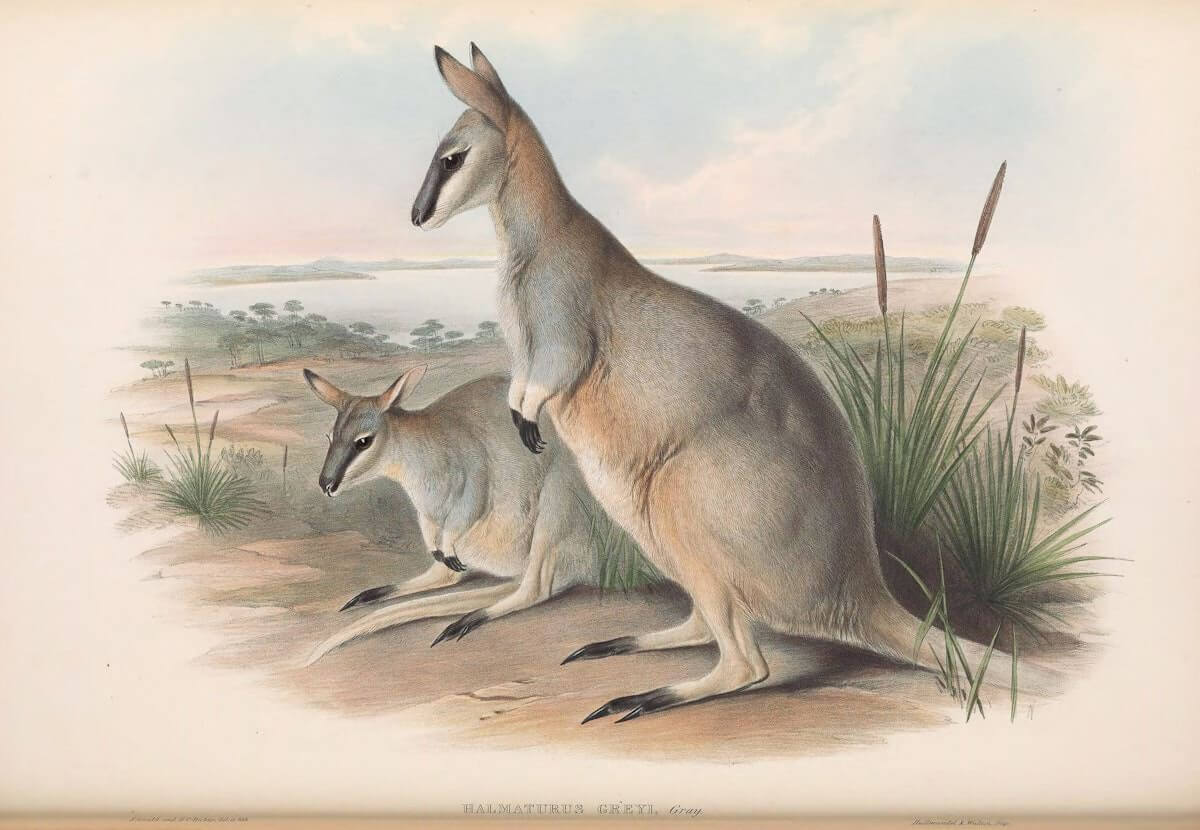
Slim, graceful, and elegant, this species of wallaby once roamed in Victoria and South Australia. Sociable, they lived in groups, finding homes in swampy areas and foraging sedgeland by twilight. Hunted for their ash-brown pelt, the toolache wallaby population was culled by the introduction of European animal predators to Australia, and further decimated when their habitats were cleared by selectors for agricultural purposes. A final 1920s attempt to save the wallaby ended in disaster when fourteen were accidentally killed by conservationists. The last recorded observation of the wallaby in the wild was in 1924, although there were hopeful --- although unconfirmed --- reports of sightings during the 1970s.
Bibron's skink
Chioninia coctei
1940

One of two species of skink named for the French zoologist Gabriel Bibron, Chioninia coctei inhabited the islets of Branco and Raso in the Cape Verde archipelago. One of the largest skink species, it was unique for having tooth crowns that were labiolingually compressed and multicuspate (ridged by cusps and bumps), and notable for its transparent lower eyelid, a mechanism that possibly allowed it to better spot predators on the ground. Its extinction is thought to have been caused by hunting, the introduction of predatory animals, and its harvesting for skink oil by native residents of the nearby islands. Marooned convicts ate a significant portion of the extant population in 1833. It was last observed in 1940.
Arabian ostrich
Struthio camelus syriacus
1941
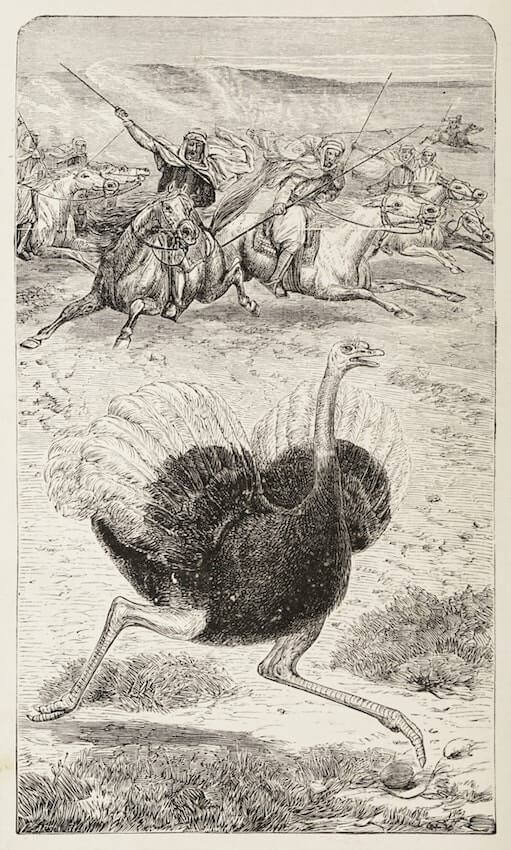
Ranging across the Arabian Peninsula, this ostrich species served as a sacrificial offering in Mesopotamia, adorned prehistoric lithic graffiti, and was thought be a fit gift for kings in Tang China. It was disparaged in the Old Testament's Book of Job --- which instead praised the parental stork --- for leaving its nest unattended. Romans stewed the ostrich, while its eggs became a peace offering in T. E. Lawrence's Seven Pillars of Wisdom (1926). The introduction of firearms and motor vehicles profoundly tipped hunting expeditions in the favor of humans, leading first to overharvesting and then extinction. Due to its genetic similarity to a North African subspecies of ostrich, attempts are ongoing to reintroduce this animal to the Arabian Peninsula.
Caribbean monk seal
Neomonachus tropicalis
1952
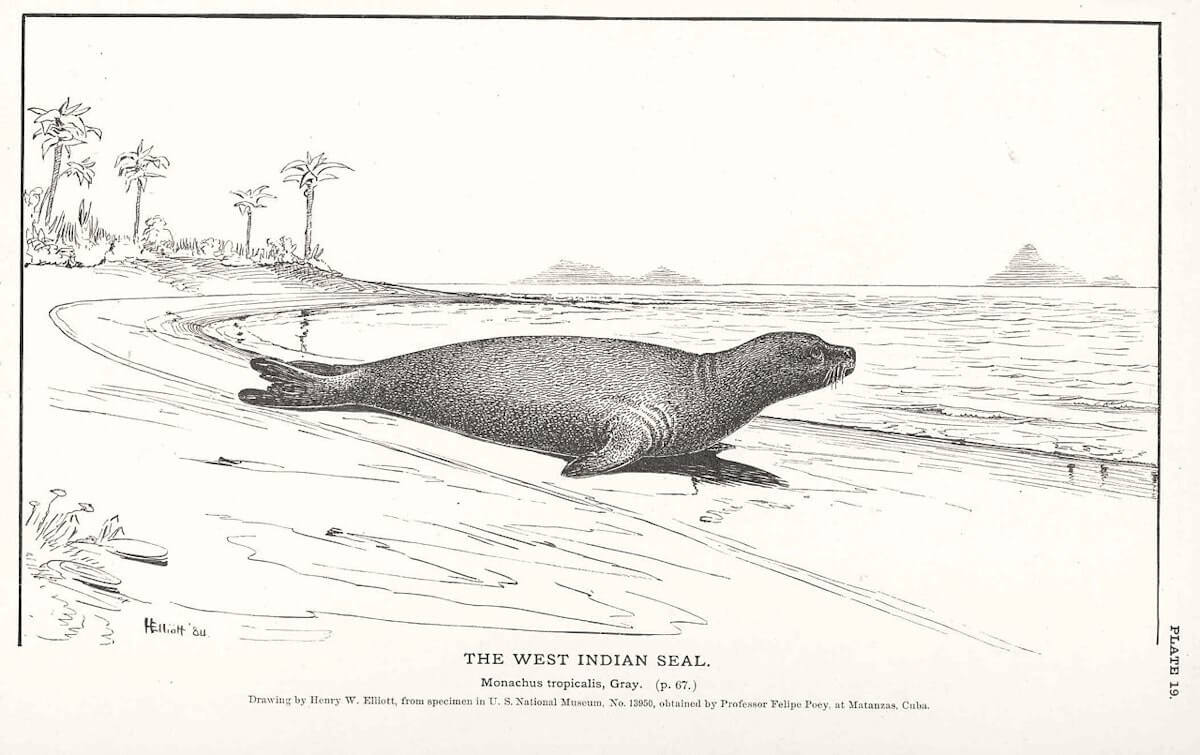
Last seen surfacing near the Serranilla Bank in 1952, this monk seal is still sometimes reported by fisherman and divers in Haiti and Jamaica, yet scientific expeditions have failed to confirm the sightings. (It is suspected that the observed animals are hooded seals, not Caribbean monk seals.) While early colonial voyages encountered the species throughout the Caribbean --- Christopher Columbus and his crew slaughtered eight of these "sea wolves" for sustenance in 1494 --- its populations are thought to have been already diminished by the fifteenth century, relegated to atolls by indigenous hunting activities. Although first recorded by Europeans four hundred years before its extinction, little scientific research was ever conducted on the species. By the nineteenth century, Caribbean monk seals had all but disappeared, overharvested by fishermen, sailors, and sealers who preyed upon the animal's genetic tameness and lack of natural defenses.
Crescent nail-tail wallaby
Onychogalea lunata
1956
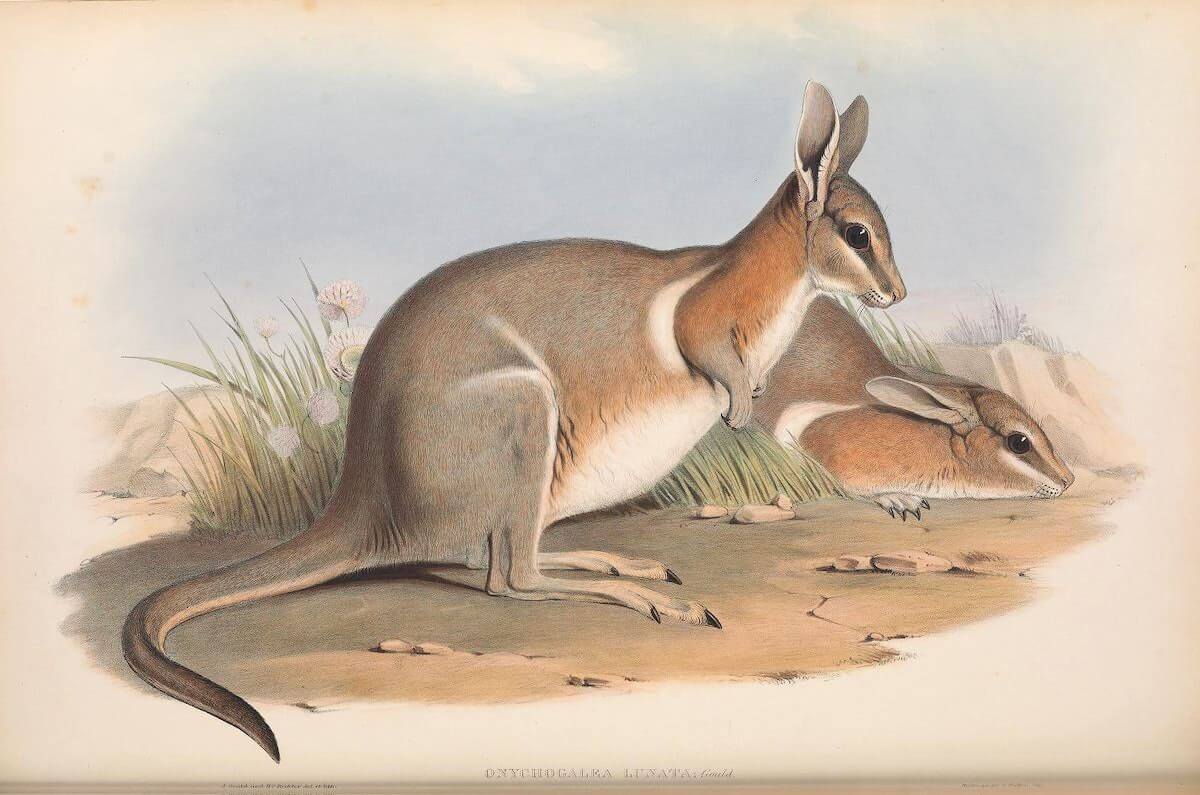
With a soft and silky pelage limned by rufous tones, this species lived in the scrub of southwestern and central Australia until at least the 1950s. Extremely timid, the crescent nail-tail wallaby was first observed at length by John Gould in 1840, who chose the specific name lunata (lunar) to describe the animal's crescent markings. In his Mammals of Australia (1863), Gould seems to hint how naturalist specimens of the species, while useful for research, cannot preserve the vitality of the living animal. "It is to be regretted that this as well as other Kangaroos lose the delicate tints of their colouring on exposure to light; so much so in the present instance, that Museum and recent specimens could scarcely be considered as identical." Known by settlers as a "kangaroo rabbit" and as yiwutta in Arrernte, the animal was frequently hunted and trapped by Aboriginal Australians, but declined rapidly after their habitat was impacted by pastoral expansion and through the introduction of European foxes and feral cats. A related species, the bridled nail-tail wallaby is currently under threat, with an estimated wild population of fewer than five hundred creatures.
Blackfin cisco
Coregonus nigripinnis
1969
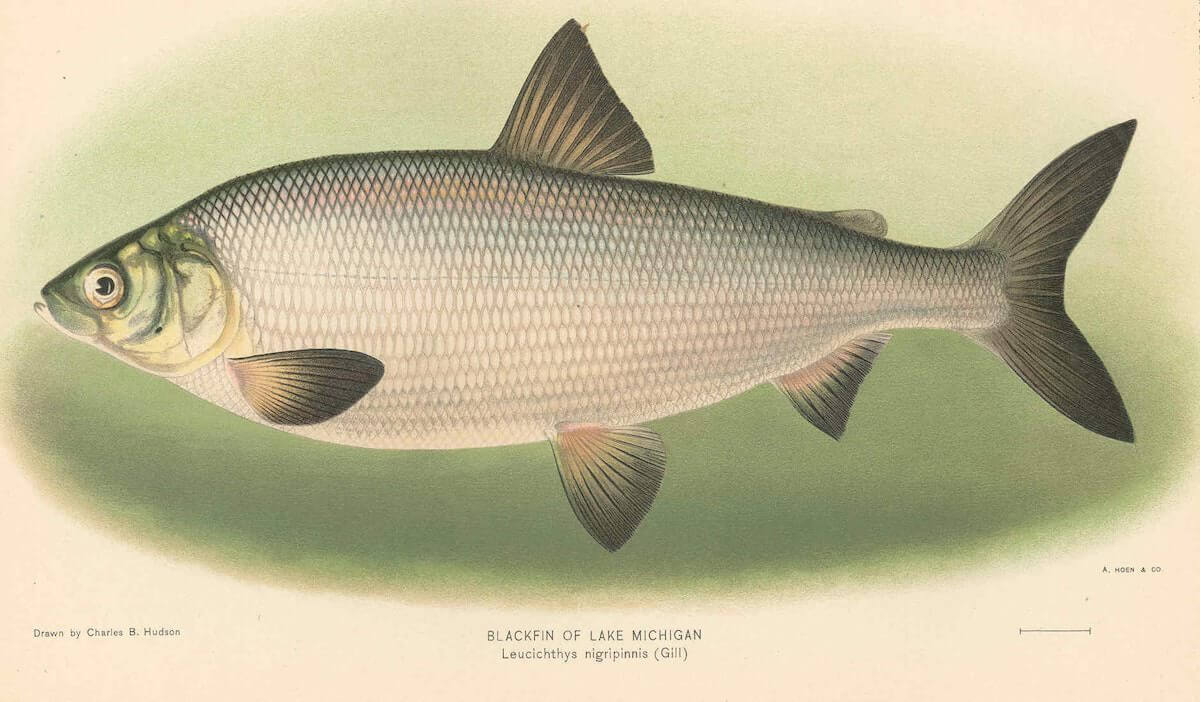
Until the mid-twentieth century, this species of freshwater whitefish was common in the Great Lakes of North America. Spawning on stony substrate, it was distinct for its green and black coloration, which provided a form of camouflage for these denizens of the deep, who lived at depths of up to six hundred feet (180 meters). Along with the longjaw and deepwater cisco, the blackfin went extinct due to overharvesting by the commercial fishing industry, competition created by introduced species, and predation by introduced alewife, rainbow smelt, and the parasitic sea lamprey, a tubular creature with nightmarish rows of keratinized teeth. Last seen in Lake Huron in 1960 and Lake Michigan in 1969, there is some controversy regarding whether or not the blackfin succumbed to introgressive hybridization --- a form of extinction that takes place when an endangered species interbreeds with an abundant population of an adjacent species.
Japanese sea lion
Zalophus japonicus
1970
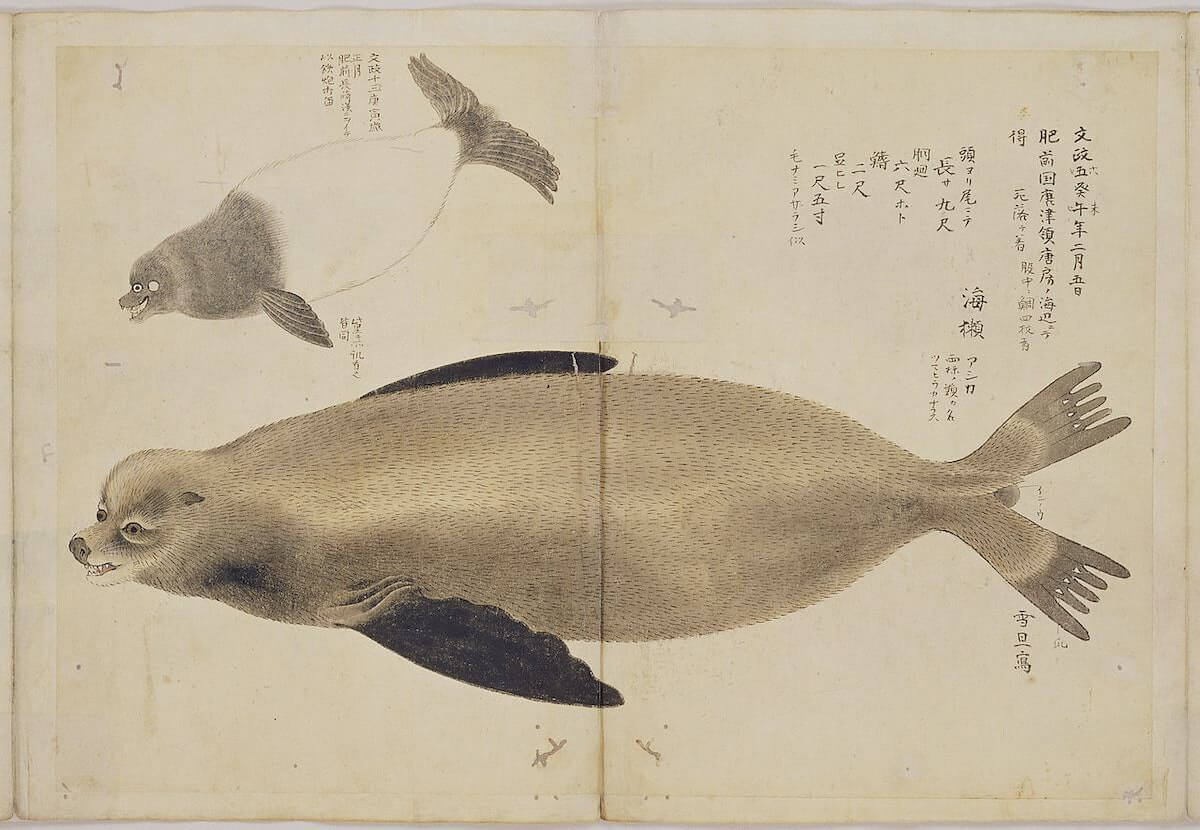
Declared extinct in the 1970s, this sea lion once traveled the Sea of Japan, frequently seen around the Japanese Archipelago and near the Korean Peninsula. Considered a subspecies of the California sea lion until 2003, these dark gray mammals rested in caves and were harvested for oil, according to an eighteenth-century Japanese encyclopedia, and, later, were captured to serve as circus attractions. Systematic trawling in the early twentieth century killed upwards of fifteen thousand Japanese sea lions --- helping to decimate a population that was once forty thousand strong in less than a century. By the 1930s, fishermen were only reporting a few dozen catches per year. While it is possible a few members of the species remain, the sea lion has not been reliably observed in more than fifty years.
Baiji
Lipotes vexillifer
2002
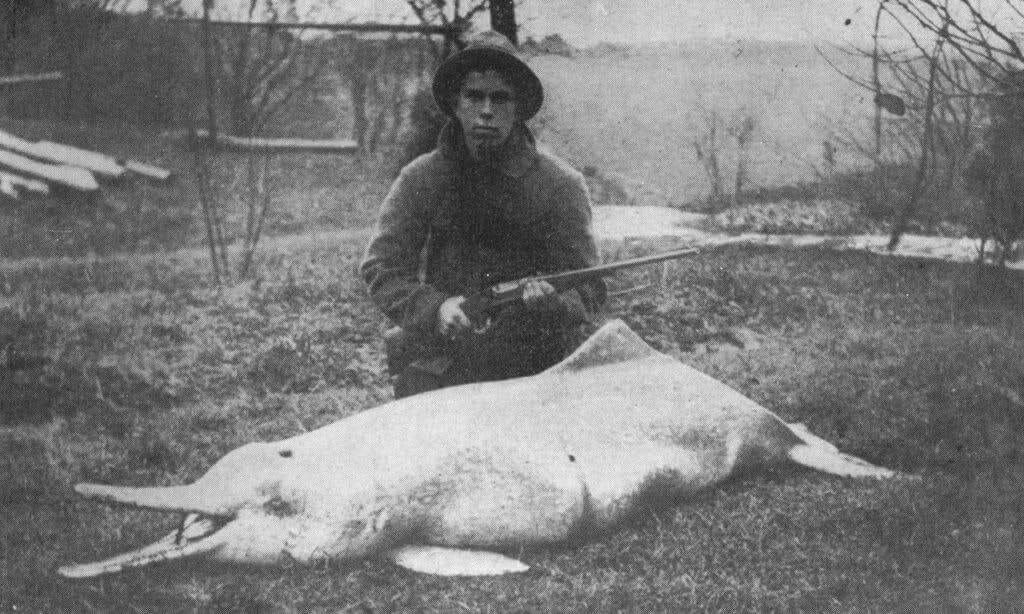
The "functionally extinct" baiji, whose Latin taxonomic designation translates to the "flag bearer left behind", lived in China's freshwater Yangtze river system, a catchment area that the cetaceans share with approximately twelve percent of the global population. Even if a few members of the species live on, this population is no longer viable for reproduction and continued survival (a 1991 expedition recorded just thirteen baijis; a 2006 expedition adjusted that number: one or two, maybe, but most likely none). Thought to be the first dolphin species extinguished by humans, the baiji has not been seen for more than twenty years, killed off by industrial pollution and the impact of development on its native waterways --- although, as Samuel Turvey notes, "early Chinese records show that river dolphins were actively exploited throughout the country's history". Weighing up to 230 kilograms (500 pounds), the baiji could live for twenty-four years in the wild, accelerating away from danger at speeds reaching sixty kilometers (thirty-seven miles) per hour. Like other cetaceans, the species relied on sonar for navigation, socialization, and emotional expression. The baiji served as an important figure of human cultural expression too. "For thousands of years, people along the Yangtze have told stories about how the baiji came to be through poems, stories, and myths", writes Lydia Pyne in Endlings: Fables for the Anthropocene. "The animals in these stories are mystical and mythical, entwining people and the river together; sometimes, in such tellings, the baiji is cast as a 'river goddess.'" The baiji did not receive notable attention in the West before 1914, when Charles Hoy, a seventeen-year-old American, shot a specimen and sent its skull to the Smithsonian Institution in Washington. The animal's last days are treated at length in Samuel Turvey's Witness to Extinction: How We Failed to Save the Yangtze River Dolphin (2009), where, among other chilling anecdotes, we are treated to a third-hand account of how the Great Leap Forward impacted this cetacean species. "Yangtze fishermen have good hearts. . . . But back then --- back then it was very difficult. Mao did some terrible things. We had to eat. We thought we had no choice. It was the dolphins, or it was our children. Which would you choose?"
Caspian tiger
Panthera tigris virgata
2003

Living in the sparse forests and riverine corridors of eastern Turkey, northern Iran, the Caucasus, and western China until the 1970s --- and, before the Middle Ages, in Ukraine and southern Russia --- this tiger's extinction is entwined with the Russian colonization of Turkestan in the late nineteenth century. It was hunted for sport; the animal's preferred reed-bed habitats were converted to cropland for cotton; and the Russian military was used to clear predators from local forests. We know little about their behavior. Conservation attempts were introduced in Tajikistan in 1938 and Iran in 1957. In the early 1970s, naturalists from the Iranian Department of Environment spent years searching for the Caspian tiger, but did not uncover any evidence of their survival. Described by Virgil and Shakespeare, this species of tiger appears more recently in Alex Dehgan's The Snow Leopard Project and Other Adventures in Warzone Conservation (2009). "The freshness of the Caspian tiger's extinction was disturbing", he writes, "we were so close to being its contemporary."
South Island kōkako
Callaeas cinereus
2007
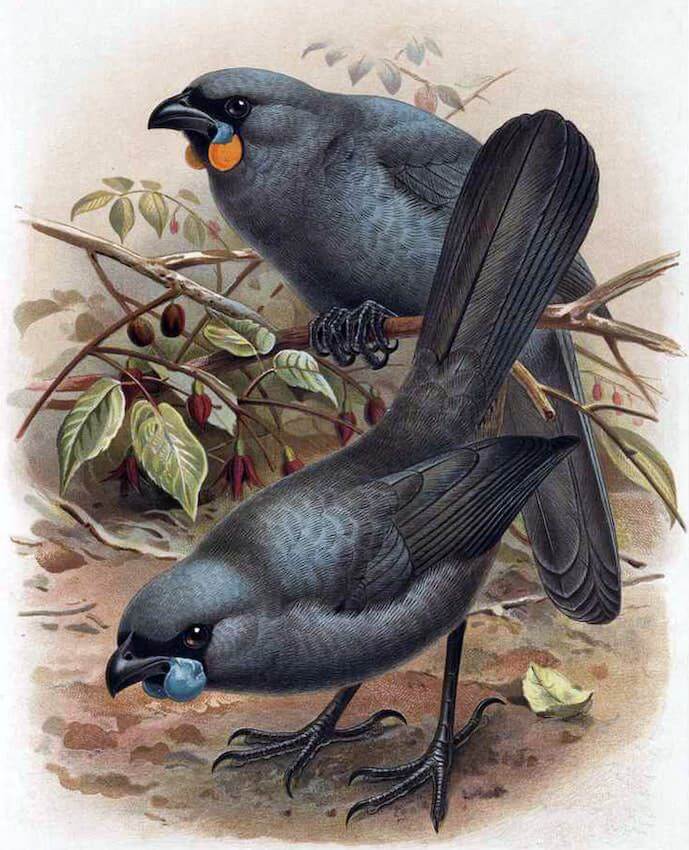
Possibly extinct, this forest bird is endemic to New Zealand's South Island, notable for its black facial mask and orange wattles, the latter of which distinguish the kōkako from a North Island relative. Last sighted in 2007 --- the first authenticated observation since 1967 --- the bird's fleeting song was memorably described by Victorian colonial surveyor Charlie Douglas: "Their notes are very few, but the sweetest and most mellow toned I have ever heard a bird produce." Males were known to perform an "archangel" display and collectives of kōkako were described in the second edition of Walter Lawry Buller's A History of the Birds of New Zealand (1888) as preferring to pass through forests on foot, in groups as large as twenty, like a flock of sheep: "if the first bird should have occasion to leap over a stone or fallen tree in the line of march, every bird in the procession follows suit accordingly!" The kōkako's range was initially impacted by Polynesian forest management, further reduced by the clear-cutting practices of European settlers as well as the introduction of mammalian predators such as ship rats in the 1860s and stoats in the 1880s. Māori traditionally hunted the bird, and it was poached by settlers for sale to collectors and museums in the nineteenth century.
Western black rhinoceros
Diceros bicornis longipes
2011

Declared extinct in 2011, this subspecies of the black rhinoceros was once widespread in the savannas of Africa, although they concentrated in Cameroon. It was distinctive for the shape of its larger horn, which had a square base, and a long distal limb. Like other rhinos, it had poor eyesight, forming symbiotic relationships with birds such as the red-billed oxpecker, who helped detect threats. The story of the western black rhinoceros' decline is "a story of greed, indifference, hope and despair", writes John R. Platt for Scientific American's Extinction Countdown blog. First came trophy hunters in the early twentieth century, then industrial agriculture, which destroyed large swaths of the animal's preferred home. And then, like the baiji, the western black rhinoceros (as well as its relatives, the southern and north-eastern black rhinoceros) were surprisingly impacted by the rise of Maoism. In a Cold War effort to promote traditional Chinese medicine over western cures, the powder of rhino horns was marketed as a panacea. Profiting off of this renewed demand, poachers arrived in Africa in record numbers, killing ninety-eight percent of black rhinoceros between 1960 and 1995. By 1997, there were estimated to be only ten endlings left, many living in isolation, making the species functionally extinct. The western black rhinoceros was last seen in 2001 and declared extinct a decade later, the same year that the Javan rhinoceros subspecies in Vietnam disappeared.
Pinta Island tortoise
Chelonoidis niger abingdonii
2012
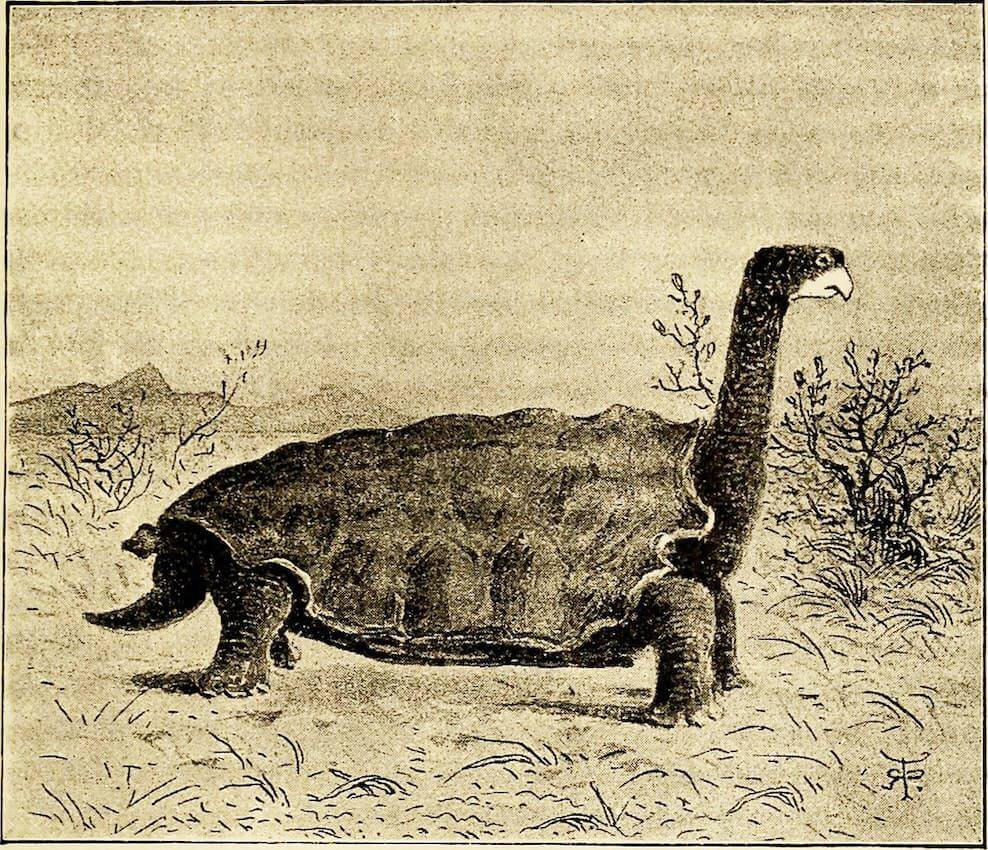
A subspecies of the Galápagos tortoise native to Ecuador's Pinta Island, this animal was presumed to be extinct by the mid-twentieth century due to uncontrolled hunting. The tortoise was first described by herpetologist Albert Günther in 1877, and the differences between subspecies of Galápagos tortoises --- adaptations suited to the distinctive environments of their different island homes --- helped Darwin formulate his theory of evolution. Like its relatives, the Pinta Island tortoise was known to rest for sixteen hours each day, and could reportedly survive almost six months without food or water. They provided a critical service to the local ecosystem, dispersing seeds and cycling nutrients for other animals and plants --- since their extinction, many other species on Pinta Island have suffered from the loss. In 1971, a single male Pinta Island tortoise was discovered and grimly nicknamed Lonesome George. Decades were unsuccessfully spent trying to mate him with other subspecies before his death in 2012. As Michael Blencowe writes, drawing attention to the sometimes oddly unnatural dynamics of conservation in last year's Gone: A Search for What Remains of the World's Extinct Creatures: "George lived the life of a celebrity. He had a luxury compound with a pool, he put on a lot of weight and the world became unhealthily obsessed with his sex life." The same year as George's death, researchers from Yale found seventeen first-generation hybrids on the neighboring Isabela Island, prompting speculation that perhaps their Pinta Island parents were still extant.
Christmas Island forest skink
Emoia nativitatis
2017

Once endemic to Christmas Island, the last known forest skink (nicknamed Gump) died in captivity in 2014. Living in leaf litter and covered by rich chocolate-colored scales, this species of skink was abundant in population as late as 1979. During the 80s and 90s, forest skink numbers plummeted by ninety-eight percent, alongside similar declines in other Christmas Island reptiles, such as the blue-tailed skink, Lister's gecko, and the coastal skink. The cause is not certain, although researchers think that habitat loss caused by introduced species, such as yellow crazy ants, are to blame. A 2021 paper lists twelve additional possible contributions to the forest skink's extinction, including predation by other species (giant centipedes, wolf snakes, black rats, and feral cats), use of the insecticide fipronil, disease, and climate change.
Smooth handfish
Sympterichthys unipennis
2020

Declared extinct and then later revised as "possibly extinct" due to insufficient data, the smooth handfish is thought to have been once commonly found off the coast of Tasmania --- so much so that it was one of the first species noted by European colonists. Using pectoral fins to walk across the seabed, the fish were described by Zoe Kean on the Guardian's Age of Extinction channel as resembling "grumpy ageing punks, each spotting a dorsal fin over its head like a mohawk, bulging eyes and a cantankerous expression." Known primarily from a sole type specimen collected during François Péron's 1802 colonial survey of Australia, this species of handfish is thought to be the first modern marine fish to have gone extinct, falling prey to environmental changes and unsustainable scallop harvesting and trawl fishing in the nineteenth and twentieth centuries.
Ivory-billed woodpecker
Campephilus principalis
2021
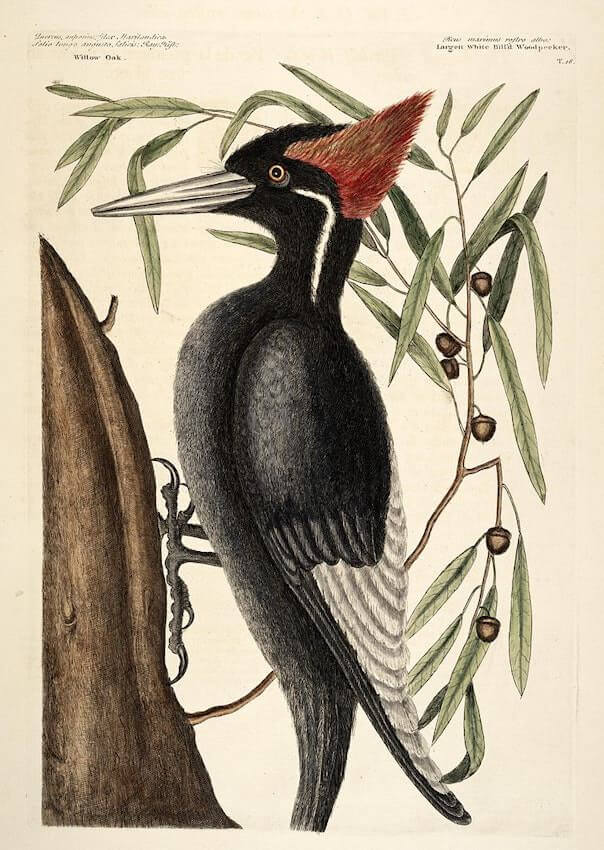
Native to the bottomland hardwood and temperate coniferous forests of Cuba and the Southern United States, the last universally accepted sighting of an American ivory-billed woodpecker was in 1944, while the last Cuban member of this species was spotted in 1987. Many subsequent sightings of this bird --- known to be John James Audobon's favorite species --- have been reported, leading to ongoing claims of rediscovery. Thought to be extinct due to widespread habitat destruction by logging, they once lived on larvae and wild fruits such as hickory nuts and persimmons. They were historically important to Native American groups from the Great Lakes and Great Plains regions, who used their bills for trade and ceremonial crafts. One of the largest woodpeckers in the world, this species had a wingspan of up to thirty inches (seventy-six centimeters). Nancy Tanner, the wife of James Taylor Tanner --- the ornithologist often credited as authoring the definitive study on the ivory-billed woodpecker --- described the magic of encountering a roosting female: "She looked huge. Her shining black-and-white plumage, white bill, and bright yellow eyes made her very conspicuous." In the wake of Tanner's study, several other narratives about searching for this dying species came to press, including Tim Gallagher's The Grail Bird (2005) and Stephen Lyn Bales' Ghost Birds (2010). In September 2021, the U.S. Fish and Wildlife Service proposed that the species should be declared extinct --- their decision on the matter is due in the coming months.

Aurochs
Bos primigenius
1627
Once widespread in Asia, Europe, and North Africa, the aurochs is believed to be a wild ancestor of domestic cattle. One of the largest herbivores in the Holocene, their grazing of nuts, twigs, and grass shaped historical ecosystems, and their manure supported vast kingdoms of insects and fungi. A prominent participant in human history --- and one of the richest food sources before the advent of agriculture --- aurochs were among the earliest figures to appear in Paleo- and Neolithic cave paintings and petroglyphs, and feature across Egyptian reliefs, Bronze Age figurines, and classical literature. (The Latin "A" descends from a Phoenician character that some believe was originally meant to represent the creature's horns, still visible when inverted: ∀). As forests were increasingly clearcut and pastures enclosed, their populations dwindled. The last surviving herd of aurochs lived in the marshy woodlands of Poland's Jaktorów Forest. The final cow passed away in 1627.

Dodo
Raphus cucullatus
1662
Famously flightless and fearless of humans, the dodo was endemic to Mauritius, evolutionarily forgoing flight due to the richness of abundant food sources and lack of immediate predators. Little remains known about their behavior or appearance (accounting for the varied depiction in naturalist illustrations) due to the narrow research window between their first recorded description, by Dutch sailors in 1598, and last accepted sighting in 1662. Mistaken for an ostrich, albatross, and vulture by colonial explorers, one of the most detailed descriptions of the bird comes from Sir Thomas Herbert's 1634 travelogue, where he characterizes the creature as having eyes like diamonds and being of a "shape and rareness [that] may antagonize the Phoenix of Arabia". Despite being sent to Europe and Asia, the last recorded captive dodo died not long after arriving in Nagasaki. Scientists state with confidence that the animal was probably extinct in the wild by 1700 from habitat loss, the introduction of predators to Mauritius, and overharvesting by humans. First used as an example of human-induced extinction in an 1883 magazine, the bird's memory lives on in Alice's Adventures in Wonderland, where, with perhaps tragic irony, the dodo declares that the best thing to help the animals would be "a Caucus-race".

Steller's sea cow
Hydrodamalis gigas
1768
Once ranging across the North Pacific during the Pleistocene epoch, by the eighteenth century, this sirenian mammal was found only around the Commander Islands in the Bering Sea. Its first recorded encounter with humans occurred in 1741, when the German botanist and explorer George Wilhelm Steller shipwrecked on Bering Island and spent a year researching wildlife while awaiting rescue, which explains how he came to describe the animal's taste as reminiscent of corned beef. An obligate herbivore, we know little about the sea cow's behavior beyond what was observed by Steller, though --- unique for its biological order --- the animal's buoyancy was so great that it was unable to submerge in water, instead harvesting kelp with its toothless, bristled mouth from across the ocean surface. Our knowledge is also limited regarding the cause of the sirenian's extinction, but it is conjectured that populations may have initially dwindled due to hunting by the Siberian Yupik people, and then were further depleted by fur traders traveling the route to Alaska pioneered by Vitus Bering. Literature readers may know the animal as the rare white seal from Rudyard Kipling's The Jungle Book and the poetry of W. G. Sebald. While later sightings were reported in the 1800s and as late as 1962, the official extinction date remains 1768, twenty-seven years after Steller discovered the sea cow.

Bluebuck
Hippotragus leucophaeus
1799
The bluebuck was a species of antelope found in South Africa until the early 1800s. With a lesser mane than roan and sable antelopes, its name derives from a distinct gray-blue coat. When European colonists encountered the animal during the seventeenth century, it was already in decline, due perhaps to a changing grassland habitat around the Cape Peninsula. Hunted to extinction by settlers within a century, biologists did not have long to observe the creature's behavior before it vanished --- many of the extant illustrations of bluebucks seem to have been based on taxidermized specimens. Originally thought to be a blue goat by Welsh naturalist Thomas Pennant, scientists now know that the animal once occupied a larger territory. It appears in shamanic paintings attributed to the San peoples and in Jules Verne's Five Weeks in a Balloon (1863), where the antelope's belly is said to be "as white as the driven snow".

Réunion giant tortoise
Cylindraspis indica
1840
Comparable in size to modern Galapagos giant tortoises, this animal was endemic to Réunion, where its vast creeps were important for maintaining the biodiversity of forests. Noted to be friendly, curious, and without fear, its populations were exploited by passing sailors in need of oil and food, further shrinking when settlers from France and Madagascar began to occupy the island in the seventeenth century. Like its fellow Mascarene giant tortoise species, the animal's slow metabolism allowed it to survive without food or water for extended periods, making it perversely suited for being packed into ship holds. While attempts at preservation were legislated for tortoises on Mauritius in the seventeenth century, meaningful protection was not offered for more than a century. The introduction of invasive species further decimated hatchling numbers, with the final observed tortoises dying off in the 1840s. One of the only taxidermized Mascarene tortoise specimens is kept in the haunting Grande Galerie de l'Évolution's Salle des Espèces Menacées et des Espèces Disparues (The Room of Endangered and Extinct Species) in Paris. As Matt Stanfield writes at the Remembrance Day for Lost Species project, "Disappearing when they did, at a time when modern science was still emerging, the Mascarene giant tortoises occupy a strange halfway house between poorly-understood human-induced casualties of the early modern era and better-known lost species of more recent times."

Southern black rhinoceros
Diceros bicornis bicornis
1850
Historically plentiful in South Africa, southern Namibia, and possibly also Lesotho and Botswana, this species of black rhinoceros went extinct around 1850 due to hunting and habitat destruction. Very little is known about the animal. Carl Linnaeus, who taxonomized the species in 1758, used a holotype of unknown provenance, with some suggesting for a time that the specimen's skull was actually an Indian rhino with a fake horn attached.

Black-fronted parakeet
Cyanoramphus zealandicus
1850
Endemic to Tahiti, the black-fronted parakeet was discovered by Europeans during James Cook's first voyage in 1769 --- when the specimens held in Liverpool and at the Walter Rothschild Zoological Museum in Tring may have been collected. A woodland species with striking violet-blue flight feathers and vibrant red lores, the parakeet survived deforestation, harvesting by Tahitians for handicrafts, and predation by pigs and kiore (Rattus exulans). With the introduction of cats and European rats to Tahiti, the black-fronted parakeet quickly became extinct as these creatures preyed on the birds and their nests, with the last reported sighting in 1850.

Hoopoe starling
Fregilupus varius
1850
Once populating Réunion, this species of starling is thought to have been first recorded by Étienne de Flacourt of the French East India Company in 1658. It was noted to be delicious by Sieur Dubois in 1674, especially "when it is fat" --- a reference to the bird's summer feeding cycles. As a twentieth-century natural historian elaborated somewhat caustically: "It became very fat in June and July, and may have itself been used for food, for it had none of the usual starling alertness, being so stupid that it could easily be knocked down with a stick." Despite this same scientist proclaiming the passerine's extinction to be "an ornithological mystery", Julian P. Hume argues that extreme deforestation was the cause, with contemporary observers recording mass culling to increase the productivity of farms. (In 1807, for example, Levaillant charged the starling with causing "big damage to coffee trees".) Eulogizing the bird's extinction in the mid-nineteenth century, Eugène Jacob de Cordemoy wrote: "I have known the bird you ask me about since childhood . . . . After ten years spent in Paris I did not find a single one in the forests where formerly they flew about in flocks. All ruthlessly destroyed. I shall never forgive myself for the part, slight though it was, which I took in the matter."

Great auk
Pinguinus impennis
1852
Classed as a flightless alcid, and the only modern species of the genus Pinguinus, this creature gave its name to penguins, as Atlantic sailors believed the latter birds were related to the auk. Historically ranging between eastern North America, Scandinavia, and the Strait of Gibraltar, the great auk mated for life, weighed about five kilograms (eleven pounds), and gurgled when anxious. Human history is tightly entwined with the bird. Its bones have been found around Neanderthal campfires, Native American burial grounds, and it helped European sailors navigate toward the Grand Banks of Newfoundland when adrift at sea. Last officially sighted in 1852, after its swift decline in the hands of harvesters selling its soft down to European clothiers, the bird's conspicuous absence resulted in novel --- though ineffective --- protective legislation to be passed in 1753. The long-running ornithology journal The Auk was named in its honor.

Falkland Islands wolf
Dusicyon australis
1876
"We barely knew the warrah", begins a recent National Geographic feature on the Falklands Islands wolf. It was first sighted by Captain John Strong in 1690, studied by Charles Darwin in 1833, and then, forty years later, was nevermore. The animal had a reputation for foxlike slyness, hence its original French name, loup-renard (wolf-fox). Darwin remembered how one stole "some meat from beneath the head of a sleeping seaman". While Thomas Huxley classed the Falklands wolf as a coyote, it is closer to the South American fox (itself not a true fox). The only endemic mammal to the Falkland Islands, the wolf was assumed to have crossed on an Ice Age land bridge to the unpeopled archipelago in some prehistoric time. Yet recent genetic research suggests that the animal left its mainland ancestors in the recent geological past (16,000 years ago), and may have been accompanied by human companions. It was hunted to extinction.

Quagga
Equus quagga quagga
1883
Named for an onomatopoeic Khoikhoi word for zebra --- thought to mimic the creature's equine call --- the quagga was endemic to South Africa until it was hunted to extinction by European settlers in the late nineteenth century. Brown and white striped, it was known to roam in herds of fifty. William Cornwallis Harris, an English military engineer and big game hunter, described the collective movement during its summer migration, unwittingly capturing the quagga's place in a landscape rich with biodiversity: "Bands of many hundreds are thus frequently seen doing their migration from the dreary and desolate plains of some portion of the interior, which has formed their secluded abode, seeking for those more luxuriant pastures where, during the summer months, various herbs thrust forth their leaves and flowers to form a green carpet, spangled with hues the most brilliant and diversified." For centuries before extinction, the quagga played an important part in human culture and agriculture, appearing in cave paintings attributed to the San peoples and used to safeguard livestock by Afrikaner farmers. When a hybrid --- the offspring of a quagga that was crossbred with a horse --- gave birth to striped children, it led to breakthroughs in theories of telegony. Writing in 1889, naturalist Henry Bryden eulogized the loss of the quagga: "That an animal so beautiful, so capable of domestication and use, and to be found not long since in so great abundance, should have been allowed to be swept from the face of the earth, is surely a disgrace to our latter-day civilization." Extinct by 1900, a stuffed quagga is held by Leiden's Naturalis Biodiversity Center, where it is trotted out for special occasions.

Portugese ibex
Capra pyrenaica lusitanica
1892
Half the length of its Pyrenean relative, there remains some debate whether or not the Portuguese ibex was a subspecies or a species of its own. Hunted by mountain-dwelling locals for meat, its ornamental horns, and the seemingly magical stone-like bezoars found in the animal's gastrointestinal tract, its decline tracks the spread and advancement of firearms. "There is little doubt that the Cabro's only significant enemy was Man", writes David Day in The Doomsday Book of Animals: A Natural History of Vanished Species (1981). The last known Portuguese ibex died in 1890, although a lone female was spotted near the Serra do Gerês in 1892.

Harelip sucker
Moxostoma lacerum
1893
A species of ray-finned fish found only in the United States, the harelip sucker has not been seen since 1893. Once considered by fishermen in Georgia, Alabama, and Tennessee as "the commonest and most valued species of sucker", it had an olive-colored back, a nonprotractile upper lip, and a notably short head. The reasons for its extinction are uncertain, but scientists suggest that the sucker died off by the siltation of its freshwater habitat through deforestation, which impacted the fish's ability to see the snails, limpets, and crustaceans on which it fed.

Sooty crayfish
Pacifastacus nigrescens
1900
Once endemic to the San Francisco Bay Area --- specifically Alameda Creek, Coyote Creek, and Steamboat Slough --- the sooty crayfish was declared extinct in 2010. It probably disappeared earlier, as it was not sighted for the entirety of the twentieth century, vanishing from its native waters as the signal crayfish was introduced, a species that carry a water mold known as crayfish plague. Overharvesting and development of the Bay Area may have also contributed to its demise. It resembled the Shasta crayfish, but was smaller and blacker in color, rarely exceeding two inches (fifty-one millimeters) in size.

Rocky Mountain locust
Melanoplus spretus
1902
This species of grasshopper was an infamous decimator of prairie farms in the 1870s. One swarm, recorded in 1875 and named after the observing physician Albert Child, was calculated to number between 3.5 and 12.5 trillion insects, encompassing some 198,000 square miles (510,000 square kilometers) of land. A western Missouri historical record remembers how they gave "an earnest and overwhelming visitation, and demonstrated with an amazing rapidity that their appetite was voracious, and that everything green belong to them for their sustenance." Its taxonomic specific name (spretus) captures the human attitude toward the grasshopper, deriving from the Latin word for "despised". (Entomologist Charles Valentine Riley invented a recipe for butter-fried locusts during blight, but was met with a public who "would just as soon starve as eat those horrible creatures".) The swarms, described by one farmer as "like a great white cloud, like a snowstorm, blocking out the sun like vapor", became a rare site in the twentieth century, due, it is thought, to the expansion and irrigation of farmland and trampling of breeding grounds by livestock. As extinction ripples up and down the animal kingdom, the Eskimo curlew's critical endangerment (or possible extinction) is thought to stem from the loss of this vital food source. The locust was formally declared extinct in 2014. Laura Ingalls Wilder's On the Banks of Plum Creek (1937) captures the awesome force of these lost locust swarms.

Bulldog rat
Rattus nativitatis
1903
Once endemic to Christmas Island in the Indian Ocean, the bulldog rat was russet colored, dwelling on hills and in thick forests. The creatures' demeanor has been described as sluggish --- avoiding daylight, for it dazed them, and never climbing into trees or shrubs. They were last seen in 1903, when sailors observed mass die offs, which were later attributed to diseases carried by black rats that had stowed away on colonial ships. Its murine neighbor on Christmas Island, Maclear's rat (Rattus macleari), followed it into extinction soon after. In March 2022, researchers in Current Biology speculated about a possible pathway toward de-extinction through gene editing, prompting some Jurassic Park style fearmongering in the popular science news.

Lithograph by John Gerrard Keulemans of a black mamo from Lionel Walter Rothschild's The Avifauna of Laysan and the Neighbouring Islands (1893) -- Source
Black mamo
Drepanis funerea
1907
Known as the hoa on its Hawaiian island of Molokai --- with a fossil record also found on the neighboring Maui --- the black mamo was known for its highly decurved bill, often dusted with pollen from lobelia flowers. Killed off by habitat destruction and the introduction of rats and mosquito-borne diseases, the last recorded specimens were captured in 1907, only fourteen years after its first recording by European naturalists. Its Latin name funereal, the same root from which we derive the word "funeral", tragically hints toward its doomed future. Alfred Newton, who taxonomized the bird, wrote that "Its sombre plumage and the sad fate that too probably awaits the species induce me to propose for it the name Drepanis funerea". Yet the bird's behavior was anything but funereal, for it was remembered as a markedly curious creature, which would seek out human proximity and respond to manmade imitations of its call. William Alanson Bryan, who published a natural history of Hawaii in 1915, captured the beauty of the bird's feeding, before loading his shotgun and killing the last specimens ever collected: "The tongue was inserted with great precision, up to the nostrils, in the flower, while the bird balanced itself on the branches, assuming almost every imaginable attitude in its operations. In all three of the birds secured, the crown was smeared with the sticky purplish white pollen of this lobelia."

Sloane's urania
Urania sloanus
1908
Named after Sir Hans Sloane, whose private collection helped found the British Museum, this species of moth was endemic in Jamaica until the last reported sighting around 1895. Its neon green, red, and blue coloration was achieved by refracting light off of ribbon-like scales, a warning to predators of its toxicity. The diurnal species lived a migratory existence, known for suddenly vanishing from areas it had previously called home. Scientists speculate that this behavior was a response to plants gradually releasing chemicals to ward off being eaten by caterpillars, accounting for an abnormal death rate observed in wild larvae broods. Sloane's urania may have succumbed to habitat loss after Jamaica's lowland rainforests were cleared and converted to agricultural land, hindering its nomadic movements.

Tarpan
Equus ferus ferus
1909
A species of small, free-ranging horse from the Russian steppe, it is uncertain whether tarpans were wild or feral creatures, hence their ferus taxonomy. They were first described by the German botanist Samuel Gottlieb Gmelin in 1771 and the last tarpan is thought to have died in captivity in 1909. They varied in color, resembling ancient depictions found in cave paintings made in Europe during the Pleistocene epoch, and some may have carried the "dun gene", sporting a blue grullo coat. They were hunted to extinction. Many domesticated horses bear phenotypic traits of the tarpan.

Passenger pigeon
Ectopistes migratorius
1914
This wild North American pigeon was named not for its ability to transport passengers, but for its wanderlust tendency to pass by (passager, in the French), before gradually passing out of existence for good, due to hunting and widespread deforestation in the nineteenth century. Living in the deciduous groves of eastern North America and breeding around the Great Lakes, the passenger pigeon's population at one point numbered between three and five billion. (A similar number range occurs in the dating of its oldest known fossil: from a specimen found in North Carolina estimated to be between 3.6 to 5.3 million years old.) It could reach airborne speeds of sixty-two miles (one hundred kilometers) per hour and caught light in its iridescent neck feathers. Wallace Craig attempted to record a different kind of tonal richness: the male pigeon's vibrant vocalizations, in musical notation and phonetic imitation, as it moved gently toward its mate: "kee-kee-kee-kee", "tete! tete! tete!" This chattering call sounded from one of the most social land birds, whose scale of loss is almost inconceivable: at their peak, passenger pigeon populations were about equal in number to all the birds that currently overwinter in North America. To give a sense of this figure, Christopher Cokinos believes that if all of the pigeons flew in a single line, they would have ringed Earth twenty-two times. For fifteen thousand years, before the arrival of European colonizers, Native American land-use practices, it is thought, worked in symbiotic relation with the birds --- promoting tree species that produced nuts, acorns, and fruits upon which the pigeons fed.

Carolina parakeet
Conuropsis carolinensis
1918
The Carolina parakeet shares a bleak historical affinity with the passenger pigeon: the species were known to flock together, and four years after the death of Martha, the last passenger pigeon, Incas --- the final captive Carolina parakeet --- died in the same cage. This small green bird, with a lemon-yellow head and ruddy face, was the only indigenous parrot to the eastern Midwest and plains states, and one of only three parrots native to the United States. It was first recorded by the English merchant venturer George Peckham in his A True Report of the Late Discoveries of the Newfound Lands (1588). The birds are thought to have been poisonous, due to cats who succumbed shortly after preying upon the parrots. Their voices imbue numerous European colonial travelogues, for the sound of parrots' cries were inseparable from the soundscape of arrival in the New World: the birdcall of a genus that did not live in Europe. Edward McIlhenny, son of the Tabasco pepper sauce tycoon, attempted to imitate their call: "While on the wing they chatter and cry continually; this cry sounds like 'qui' with the rising inflection on the i; this is repeated several times, the last one being drawn out like 'qui-i-i-i'." Yet by the nineteenth century, travelers were already noting the mournful silence that signaled their decline. The cause of their extinction is multifold: deforestation, hunting, capture by the pet trade, and competition for nesting sites by introduced species. Known to flock to the site of dead and dying birds, opportunists would exploit this behavior for wholesale slaughter.

Florida black wolf
Canis rufus floridanus
1934
Once roaming throughout the lower southeast of the United States, the Florida black wolf hunted bison in prairies and pine forests. While initially thought to be a type of coyote, scientific consensus now believes that the animal was a subspecies of red wolf. Jet black, with the exception of white highlights on its chest and snout, this predator was declared extinct in 1908, forced out of its natural habitat by homesteaders pushing into the hinterland, who saw the wolf as a threat to livestock.

Hawaiʻi ʻōʻō
Moho nobilis
1934
Reportedly common on the Big Island in 1891 and 1892, this yellow-tufted bee-eater had disappeared two years later, which contemporary observers believed resulted from prize hunting and from forest lands being cleared for coffee plantations and browsing livestock. The last specimen was collected in 1902, although a senior Hawaiian ornithologist swears to have heard one hidden amid the flanks of the active volcano Mauna Loa in 1934. Notably timid, the nectivorous ʻōʻō had an extended tongue for probing lobelias and made a hummingbird-like buzzing while hovering. Robert Perkins, who Julian Pender Hume describes as spending weeks on the mountains of Hawaii bare-foot and on horseback, recorded the bird as displaying an aggressiveness that "appears so wanton and unnecessary, and so frequently interrupts its own feeding, that one suspects it must be an ancient habit, which has survived from a time when either nectar-producing flowers were scarcer, or the birds which feed upon them were more numerous." The islands of Molokai and Maui also were home to species of Moho, which --- like the Hawai'ian ʻōʻō --- are now extinct.

Thylacine (or Tasmanian tiger)
Thylacinus cynocephalus
1936
The darkly-striped thylacine was a marsupial, not a tiger, and had many canine characteristics. Formerly it lived on New Guinea and the Australian mainland, but met its end on Tasmania, with the last captive specimen outside of Oceania dying in 1931. Its tigrine features are present in rock art dating back to at least 1000 BCE. Observing the animal's footprints in 1642, Dutch colonist Abel Tasman described them as "wild beasts having claws like a Tyger". Surprising settlers by sporting a kangaroo-like pouch, the thylacine's combination of characteristics led it to be later described as a "dog-headed opossum" by naturalists, and a transformation of the striped archerfish by Kunwinjku Aboriginals. Thought to have been hunted to near extinction by early humans, the last thylacines succumbed to bounty schemes introduced by Van Diemen's Land Company in the nineteenth century, after thylacines were blamed for the death of sheep, with what is thought to be the final thylacine shot by a farmer named Wilf Batty in 1930. Before extinction, its visual hybridity inspired a wealth of engravings, lithographs, and drawings, collected in Carol Freeman's Paper Tiger: A Visual History of the Thylacine.

Toolache wallaby
Macropus greyi
1939
Slim, graceful, and elegant, this species of wallaby once roamed in Victoria and South Australia. Sociable, they lived in groups, finding homes in swampy areas and foraging sedgeland by twilight. Hunted for their ash-brown pelt, the toolache wallaby population was culled by the introduction of European animal predators to Australia, and further decimated when their habitats were cleared by selectors for agricultural purposes. A final 1920s attempt to save the wallaby ended in disaster when fourteen were accidentally killed by conservationists. The last recorded observation of the wallaby in the wild was in 1924, although there were hopeful --- although unconfirmed --- reports of sightings during the 1970s.

Bibron's skink
Chioninia coctei
1940
One of two species of skink named for the French zoologist Gabriel Bibron, Chioninia coctei inhabited the islets of Branco and Raso in the Cape Verde archipelago. One of the largest skink species, it was unique for having tooth crowns that were labiolingually compressed and multicuspate (ridged by cusps and bumps), and notable for its transparent lower eyelid, a mechanism that possibly allowed it to better spot predators on the ground. Its extinction is thought to have been caused by hunting, the introduction of predatory animals, and its harvesting for skink oil by native residents of the nearby islands. Marooned convicts ate a significant portion of the extant population in 1833. It was last observed in 1940.

Arabian ostrich
Struthio camelus syriacus
1941
Ranging across the Arabian Peninsula, this ostrich species served as a sacrificial offering in Mesopotamia, adorned prehistoric lithic graffiti, and was thought be a fit gift for kings in Tang China. It was disparaged in the Old Testament's Book of Job --- which instead praised the parental stork --- for leaving its nest unattended. Romans stewed the ostrich, while its eggs became a peace offering in T. E. Lawrence's Seven Pillars of Wisdom (1926). The introduction of firearms and motor vehicles profoundly tipped hunting expeditions in the favor of humans, leading first to overharvesting and then extinction. Due to its genetic similarity to a North African subspecies of ostrich, attempts are ongoing to reintroduce this animal to the Arabian Peninsula.

Caribbean monk seal
Neomonachus tropicalis
1952
Last seen surfacing near the Serranilla Bank in 1952, this monk seal is still sometimes reported by fisherman and divers in Haiti and Jamaica, yet scientific expeditions have failed to confirm the sightings. (It is suspected that the observed animals are hooded seals, not Caribbean monk seals.) While early colonial voyages encountered the species throughout the Caribbean --- Christopher Columbus and his crew slaughtered eight of these "sea wolves" for sustenance in 1494 --- its populations are thought to have been already diminished by the fifteenth century, relegated to atolls by indigenous hunting activities. Although first recorded by Europeans four hundred years before its extinction, little scientific research was ever conducted on the species. By the nineteenth century, Caribbean monk seals had all but disappeared, overharvested by fishermen, sailors, and sealers who preyed upon the animal's genetic tameness and lack of natural defenses.

Crescent nail-tail wallaby
Onychogalea lunata
1956
With a soft and silky pelage limned by rufous tones, this species lived in the scrub of southwestern and central Australia until at least the 1950s. Extremely timid, the crescent nail-tail wallaby was first observed at length by John Gould in 1840, who chose the specific name lunata (lunar) to describe the animal's crescent markings. In his Mammals of Australia (1863), Gould seems to hint how naturalist specimens of the species, while useful for research, cannot preserve the vitality of the living animal. "It is to be regretted that this as well as other Kangaroos lose the delicate tints of their colouring on exposure to light; so much so in the present instance, that Museum and recent specimens could scarcely be considered as identical." Known by settlers as a "kangaroo rabbit" and as yiwutta in Arrernte, the animal was frequently hunted and trapped by Aboriginal Australians, but declined rapidly after their habitat was impacted by pastoral expansion and through the introduction of European foxes and feral cats. A related species, the bridled nail-tail wallaby is currently under threat, with an estimated wild population of fewer than five hundred creatures.

Blackfin cisco
Coregonus nigripinnis
1969
Until the mid-twentieth century, this species of freshwater whitefish was common in the Great Lakes of North America. Spawning on stony substrate, it was distinct for its green and black coloration, which provided a form of camouflage for these denizens of the deep, who lived at depths of up to six hundred feet (180 meters). Along with the longjaw and deepwater cisco, the blackfin went extinct due to overharvesting by the commercial fishing industry, competition created by introduced species, and predation by introduced alewife, rainbow smelt, and the parasitic sea lamprey, a tubular creature with nightmarish rows of keratinized teeth. Last seen in Lake Huron in 1960 and Lake Michigan in 1969, there is some controversy regarding whether or not the blackfin succumbed to introgressive hybridization --- a form of extinction that takes place when an endangered species interbreeds with an abundant population of an adjacent species.

Japanese sea lion
Zalophus japonicus
1970
Declared extinct in the 1970s, this sea lion once traveled the Sea of Japan, frequently seen around the Japanese Archipelago and near the Korean Peninsula. Considered a subspecies of the California sea lion until 2003, these dark gray mammals rested in caves and were harvested for oil, according to an eighteenth-century Japanese encyclopedia, and, later, were captured to serve as circus attractions. Systematic trawling in the early twentieth century killed upwards of fifteen thousand Japanese sea lions --- helping to decimate a population that was once forty thousand strong in less than a century. By the 1930s, fishermen were only reporting a few dozen catches per year. While it is possible a few members of the species remain, the sea lion has not been reliably observed in more than fifty years.

Baiji
Lipotes vexillifer
2002
The "functionally extinct" baiji, whose Latin taxonomic designation translates to the "flag bearer left behind", lived in China's freshwater Yangtze river system, a catchment area that the cetaceans share with approximately twelve percent of the global population. Even if a few members of the species live on, this population is no longer viable for reproduction and continued survival (a 1991 expedition recorded just thirteen baijis; a 2006 expedition adjusted that number: one or two, maybe, but most likely none). Thought to be the first dolphin species extinguished by humans, the baiji has not been seen for more than twenty years, killed off by industrial pollution and the impact of development on its native waterways --- although, as Samuel Turvey notes, "early Chinese records show that river dolphins were actively exploited throughout the country's history". Weighing up to 230 kilograms (500 pounds), the baiji could live for twenty-four years in the wild, accelerating away from danger at speeds reaching sixty kilometers (thirty-seven miles) per hour. Like other cetaceans, the species relied on sonar for navigation, socialization, and emotional expression. The baiji served as an important figure of human cultural expression too. "For thousands of years, people along the Yangtze have told stories about how the baiji came to be through poems, stories, and myths", writes Lydia Pyne in Endlings: Fables for the Anthropocene. "The animals in these stories are mystical and mythical, entwining people and the river together; sometimes, in such tellings, the baiji is cast as a 'river goddess.'" The baiji did not receive notable attention in the West before 1914, when Charles Hoy, a seventeen-year-old American, shot a specimen and sent its skull to the Smithsonian Institution in Washington. The animal's last days are treated at length in Samuel Turvey's Witness to Extinction: How We Failed to Save the Yangtze River Dolphin (2009), where, among other chilling anecdotes, we are treated to a third-hand account of how the Great Leap Forward impacted this cetacean species. "Yangtze fishermen have good hearts. . . . But back then --- back then it was very difficult. Mao did some terrible things. We had to eat. We thought we had no choice. It was the dolphins, or it was our children. Which would you choose?"

Caspian tiger
Panthera tigris virgata
2003
Living in the sparse forests and riverine corridors of eastern Turkey, northern Iran, the Caucasus, and western China until the 1970s --- and, before the Middle Ages, in Ukraine and southern Russia --- this tiger's extinction is entwined with the Russian colonization of Turkestan in the late nineteenth century. It was hunted for sport; the animal's preferred reed-bed habitats were converted to cropland for cotton; and the Russian military was used to clear predators from local forests. We know little about their behavior. Conservation attempts were introduced in Tajikistan in 1938 and Iran in 1957. In the early 1970s, naturalists from the Iranian Department of Environment spent years searching for the Caspian tiger, but did not uncover any evidence of their survival. Described by Virgil and Shakespeare, this species of tiger appears more recently in Alex Dehgan's The Snow Leopard Project and Other Adventures in Warzone Conservation (2009). "The freshness of the Caspian tiger's extinction was disturbing", he writes, "we were so close to being its contemporary."

South Island kōkako
Callaeas cinereus
2007
Possibly extinct, this forest bird is endemic to New Zealand's South Island, notable for its black facial mask and orange wattles, the latter of which distinguish the kōkako from a North Island relative. Last sighted in 2007 --- the first authenticated observation since 1967 --- the bird's fleeting song was memorably described by Victorian colonial surveyor Charlie Douglas: "Their notes are very few, but the sweetest and most mellow toned I have ever heard a bird produce." Males were known to perform an "archangel" display and collectives of kōkako were described in the second edition of Walter Lawry Buller's A History of the Birds of New Zealand (1888) as preferring to pass through forests on foot, in groups as large as twenty, like a flock of sheep: "if the first bird should have occasion to leap over a stone or fallen tree in the line of march, every bird in the procession follows suit accordingly!" The kōkako's range was initially impacted by Polynesian forest management, further reduced by the clear-cutting practices of European settlers as well as the introduction of mammalian predators such as ship rats in the 1860s and stoats in the 1880s. Māori traditionally hunted the bird, and it was poached by settlers for sale to collectors and museums in the nineteenth century.

Western black rhinoceros
Diceros bicornis longipes
2011
Declared extinct in 2011, this subspecies of the black rhinoceros was once widespread in the savannas of Africa, although they concentrated in Cameroon. It was distinctive for the shape of its larger horn, which had a square base, and a long distal limb. Like other rhinos, it had poor eyesight, forming symbiotic relationships with birds such as the red-billed oxpecker, who helped detect threats. The story of the western black rhinoceros' decline is "a story of greed, indifference, hope and despair", writes John R. Platt for Scientific American's Extinction Countdown blog. First came trophy hunters in the early twentieth century, then industrial agriculture, which destroyed large swaths of the animal's preferred home. And then, like the baiji, the western black rhinoceros (as well as its relatives, the southern and north-eastern black rhinoceros) were surprisingly impacted by the rise of Maoism. In a Cold War effort to promote traditional Chinese medicine over western cures, the powder of rhino horns was marketed as a panacea. Profiting off of this renewed demand, poachers arrived in Africa in record numbers, killing ninety-eight percent of black rhinoceros between 1960 and 1995. By 1997, there were estimated to be only ten endlings left, many living in isolation, making the species functionally extinct. The western black rhinoceros was last seen in 2001 and declared extinct a decade later, the same year that the Javan rhinoceros subspecies in Vietnam disappeared.

Pinta Island tortoise
Chelonoidis niger abingdonii
2012
A subspecies of the Galápagos tortoise native to Ecuador's Pinta Island, this animal was presumed to be extinct by the mid-twentieth century due to uncontrolled hunting. The tortoise was first described by herpetologist Albert Günther in 1877, and the differences between subspecies of Galápagos tortoises --- adaptations suited to the distinctive environments of their different island homes --- helped Darwin formulate his theory of evolution. Like its relatives, the Pinta Island tortoise was known to rest for sixteen hours each day, and could reportedly survive almost six months without food or water. They provided a critical service to the local ecosystem, dispersing seeds and cycling nutrients for other animals and plants --- since their extinction, many other species on Pinta Island have suffered from the loss. In 1971, a single male Pinta Island tortoise was discovered and grimly nicknamed Lonesome George. Decades were unsuccessfully spent trying to mate him with other subspecies before his death in 2012. As Michael Blencowe writes, drawing attention to the sometimes oddly unnatural dynamics of conservation in last year's Gone: A Search for What Remains of the World's Extinct Creatures: "George lived the life of a celebrity. He had a luxury compound with a pool, he put on a lot of weight and the world became unhealthily obsessed with his sex life." The same year as George's death, researchers from Yale found seventeen first-generation hybrids on the neighboring Isabela Island, prompting speculation that perhaps their Pinta Island parents were still extant.

Christmas Island forest skink
Emoia nativitatis
2017
Once endemic to Christmas Island, the last known forest skink (nicknamed Gump) died in captivity in 2014. Living in leaf litter and covered by rich chocolate-colored scales, this species of skink was abundant in population as late as 1979. During the 80s and 90s, forest skink numbers plummeted by ninety-eight percent, alongside similar declines in other Christmas Island reptiles, such as the blue-tailed skink, Lister's gecko, and the coastal skink. The cause is not certain, although researchers think that habitat loss caused by introduced species, such as yellow crazy ants, are to blame. A 2021 paper lists twelve additional possible contributions to the forest skink's extinction, including predation by other species (giant centipedes, wolf snakes, black rats, and feral cats), use of the insecticide fipronil, disease, and climate change.

Smooth handfish
Sympterichthys unipennis
2020
Declared extinct and then later revised as "possibly extinct" due to insufficient data, the smooth handfish is thought to have been once commonly found off the coast of Tasmania --- so much so that it was one of the first species noted by European colonists. Using pectoral fins to walk across the seabed, the fish were described by Zoe Kean on the Guardian's Age of Extinction channel as resembling "grumpy ageing punks, each spotting a dorsal fin over its head like a mohawk, bulging eyes and a cantankerous expression." Known primarily from a sole type specimen collected during François Péron's 1802 colonial survey of Australia, this species of handfish is thought to be the first modern marine fish to have gone extinct, falling prey to environmental changes and unsustainable scallop harvesting and trawl fishing in the nineteenth and twentieth centuries.

Ivory-billed woodpecker
Campephilus principalis
2021
Native to the bottomland hardwood and temperate coniferous forests of Cuba and the Southern United States, the last universally accepted sighting of an American ivory-billed woodpecker was in 1944, while the last Cuban member of this species was spotted in 1987. Many subsequent sightings of this bird --- known to be John James Audobon's favorite species --- have been reported, leading to ongoing claims of rediscovery. Thought to be extinct due to widespread habitat destruction by logging, they once lived on larvae and wild fruits such as hickory nuts and persimmons. They were historically important to Native American groups from the Great Lakes and Great Plains regions, who used their bills for trade and ceremonial crafts. One of the largest woodpeckers in the world, this species had a wingspan of up to thirty inches (seventy-six centimeters). Nancy Tanner, the wife of James Taylor Tanner --- the ornithologist often credited as authoring the definitive study on the ivory-billed woodpecker --- described the magic of encountering a roosting female: "She looked huge. Her shining black-and-white plumage, white bill, and bright yellow eyes made her very conspicuous." In the wake of Tanner's study, several other narratives about searching for this dying species came to press, including Tim Gallagher's The Grail Bird (2005) and Stephen Lyn Bales' Ghost Birds (2010). In September 2021, the U.S. Fish and Wildlife Service proposed that the species should be declared extinct --- their decision on the matter is due in the coming months.